Where we live and why

good-bye city, hello farm
In search of housing security
2 families, 1 home
Loving co-housing

R SEATTLESCHILD.COM
YOUR GUIDE TO A KID FRIENDLY CITY -
MARCH/ APRIL 2024 FREE
INSIDE Party! Guide


2 SEATTLE’S CHILD March/April 2024

20th Anniversary
March 21st-April 4th


Moisture Festival once again presents our Moisture Festival once again presents our signature high energy comedy/varieté shows, signature high energy comedy/varieté shows, all accompanied by a live show band. all accompanied by a live show band.
Aerialists, acrobats, Aerialists, acrobats, jugglers, physical jugglers, physical comedians, clowns, comedians, clowns, magicians, dancers, and magicians, dancers, and musicians are just some musicians are just some of the awe-inspiring acts of the awe-inspiring acts you'll find at the Moisture you'll find at the Moisture Festival! Festival!


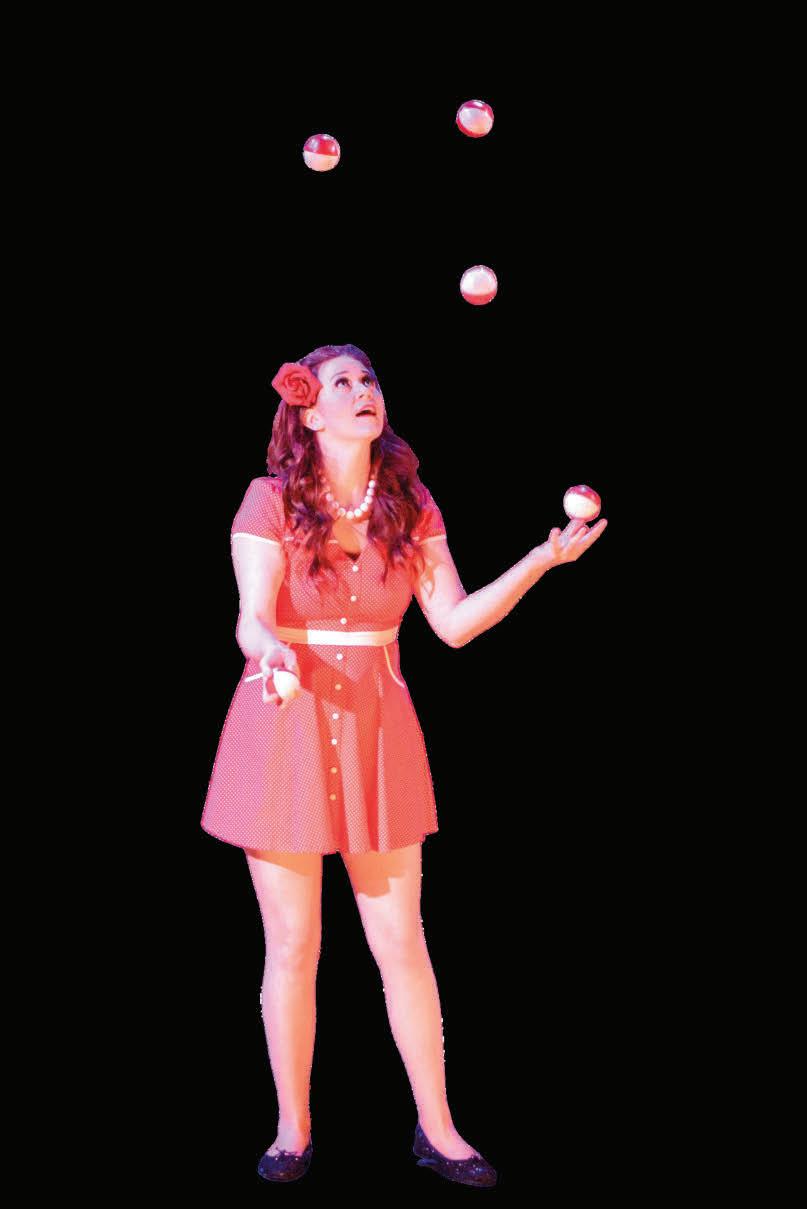


W!
SEATTLE SEATTLE MOISTURE MOISTURE MOISTURE FESTIVAL FESTIVAL FESTIVAL
SEATTLE
Scanfor Tickets moisturefestival.org March/April 2024 SEATTLE’S CHILD 3
Contents Seattle’sChild „ Find us online at seattleschild.com ON THE COVER Hillarie Maddox and Udie Chima, Whidbey island PHOTO BY JOSHUA HUSTON March/April 2024 // Issue 504 p.9 WHAT PARENTS ARE TALKING ABOUT 5 DAD NEXT DOOR 7 ROMP 9 CHOMP 13 FEATURE: WHERE WE LIVE (AND WHY) 22 2 FAMILIES, 1 HOME 23 A POLYCULE FAMILY 24 FROM CITY TO COUNTRY 26 IN SEARCH OF HOUSING SECURITY 28 ARCH HOMEBUYING 30 3 GENERATION HOME 31 LOVING CO-HOUSING 32 HOME-STUDIOGALLERY 34 ARTIST CO-OP IS HOME ................................. 36 6 PEOPLE, 2 DOGS, 925 SQ.FT. 37 p.13
>>
Looking for camps and classes?
Check out our Summer Directory for a variety of options for every interest and age.

Seattle’sChild
March/April 2024 // Issue 504


seattleschild.com/camp


A portion of the proceeds from each birth certificate benefits the Children’s Trust Fund of Washington, administered by the Washington State Department of Children, Youth & Families Strengthening Families Program.
• This official birth certificate is personally signed by the Governor and State Registrar.


“Seattle is my town. I know this city inside and out… or so I thought until I had kids.”
Seattle’s Child is your guide to getting to know your city all over again. Finding things to do, places to eat, and how to get around — it’s a whole new ballgame with kids in tow. We’re interested in how parents make homes in a space-challenged urban environment, how families create community, and what parents are really talking about. Seattle’s Child reflects real Washington families and their broad range of parenting experiences.
ANN BERGMAN Publisher, Founder abergman@seattleschild.com
JASMIN THANKACHEN Associate Publisher jasmin@seattleschild.com
KATHRYN HOLLOWAY Art Director
CHERYL MURFIN Managing Editor cheryl@seattleschild.com
JOSHUA HUSTON
Photographer
ROSE WILLIAMSON Proofreader
JEFF LEE, MD Columnist
DR. SUSANNA BLOCK
KAIYA DECORY-KEEN
TIFFANY GUERZON
ELIZABETH HUNTER MELODY IP JOAN KING
CHERYL MURFIN Contributors
ADVERTISING
JULANN HILL
Senior Account Manager julann@seattleschild.com 206-724-2453


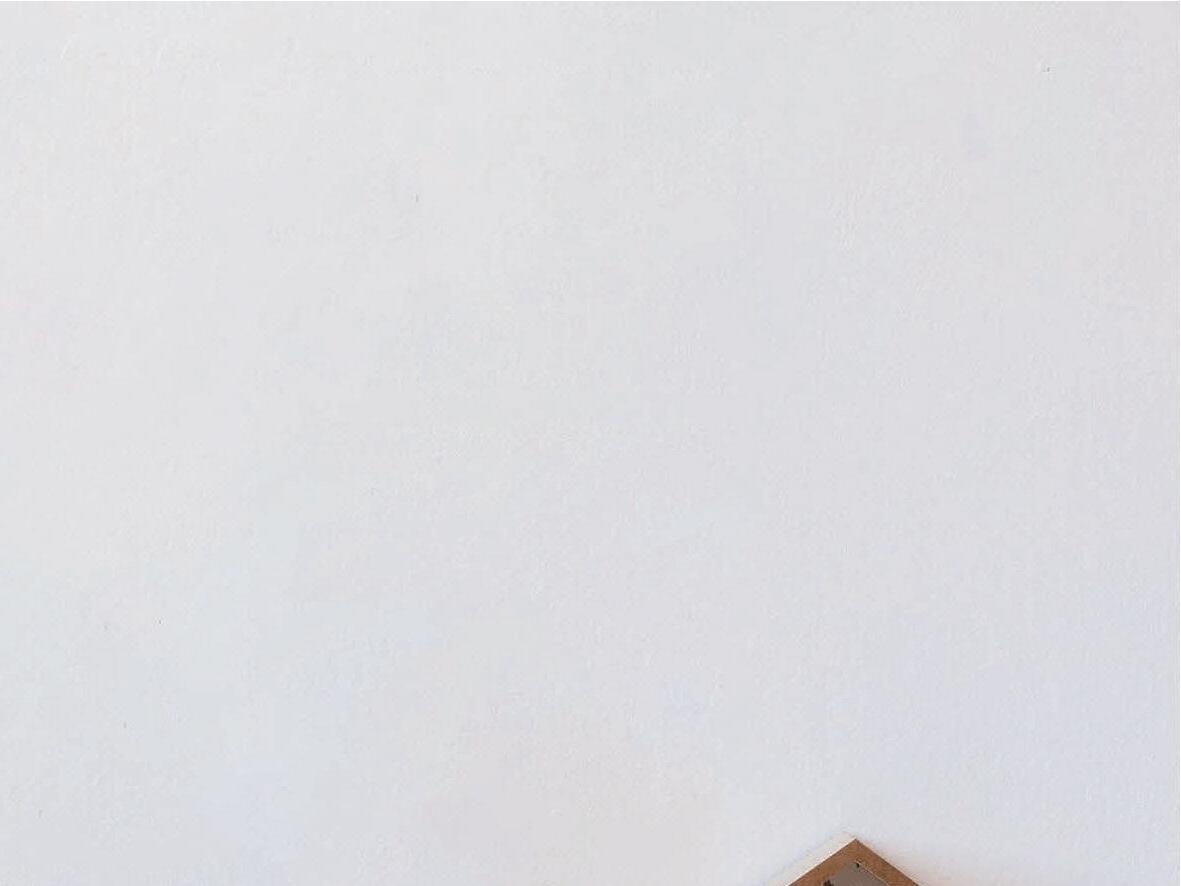
• Frameable keepsake.
• For each $45 purchase of an Heirloom Birth Certificate, $20 is tax deductible.

To find out more information on Children’s Trust and child abuse prevention in Washington State visit: www.dcyf.wa.gov/about/governmentcommunity/community-engagement or visit the Department of Health to order your own Heirloom Birth Certificate.
DCYF FS_0010 (09-19)


ERICA GILSON Account Executive erica@seattleschild.com
AMBER ELBON Ad Production Manager amber@seattleschild.com


• Certificate is 8 1/2 x 11 and includes the name, date and place of birth, as well as the name and birthplace of the parent(s).






Seattle’sChild
Seattle’s Child has provided useful information to parents since 1979. In addition to our magazine, look for our special themed publications — Family Guide, School, Explore and SummerTime — distributed free throughout the Puget Sound area. Seattle’s Child is published every other month.
ONLINE seattleschild.com
Facebook facebook.com/seattleschild
Twitter @SeaChildMag
Instagram @seattleschildmag
MAIL c/o Postal Plus
1211 E. Denny Way, Seattle, WA 98112
VOICE 206-441-0191
TO ADVERTISE advertise@seattleschild.com
MAGAZINE DISTRIBUTION distribution@seattleschild.com
STORY IDEAS editor@seattleschild.com
CALENDAR SUBMISSIONS calendar@seattleschild.com
Include date, time, cost, appropriate ages, address, contact information and description.
It’s so much more than a gift! Washington State Heirloom Birth Certificate
4 SEATTLE’S CHILD March/April 2024
»What Parents Are Talking About

Having Narcan saves young lives
A dad, brother, and overdose expert makes the case
by CHERYL MURFIN / photograph by JOSHUA HUSTON
In recent months, there’s been a lot of discussion of Narcan, the drug that rapidly reverses opioid overdose. The U.S. Food and Drug Administration approved the medication for over-thecounter sale last March.
Should every parent keep Narcan (naloxone) in their medicine cabinet and a dose in their pocket — just in case? Should
teens, even if they don’t use drugs, be taught how to administer the nasal pump and be encouraged to carry it?
We brought these questions to Brad Finegood — a man who follows drug and overdose trends closely. Finegood is Public Health - Seattle & King County’s strategic overdose prevention and response advisor. Moreover, he knows personally the grief
of losing a loved one to overdose — his beloved brother died that way. And perhaps most important, Finegood is a father. Here are his thoughts:
Seattle’s Child (SC): Is the opioid, and in particular the fentanyl, situation in King County as bad as it sounds?
Brad Finegood: I don’t ever want to use scare tactics. What I will say is that fentanyl has really changed the game. For years
March/April 2024 SEATTLE’S CHILD 5
development
CONTINUED ON NEXT PAGE >
Education, health,
and more
„ Find more local stories for families on seattleschild.com Don’t miss these stories on seattleschild.com Docent tips: How to visit a museum with a child When ‘I’m Bored’ means ‘I Want Screentime’
Anchor it! A mother turns a tragedy into advocacy
1 2
3
For the resources,interviewfulland check out “Should Narcan be in the family medicineonlinecabinet?” at 3Seattleschild.com
Brad Finegood, the strategic overdose prevention and response advisor for Public Health - Seattle & King County, and son.



«What Parents Are Talking About
and years and years and years, to get to a lethal amount of drug, someone needed to inject or inhale it. Today, you’ve got kids saying, ‘I’m never going to inject drugs!’ Like it’s a safety threshold they won’t cross, so they’re safe.
home?
Finegood: I’m really open with my kids and interested in what they’re seeing, what they’re understanding, how they’re experiencing things, and talking through things. I said, ‘Hey, I care, and I will have this in the house. I just want you to know, and I want you to feel comfortable with it. This isn’t a judgment on you.’ If there’s ever a situation where we need it for them, or they need it for any of their friends, it’s here.



SC: What does overdose look like?








































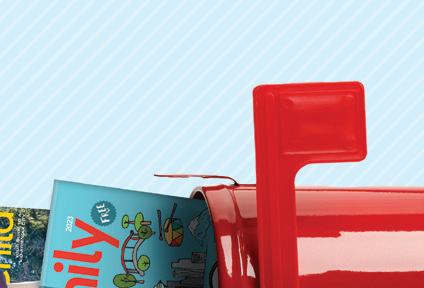


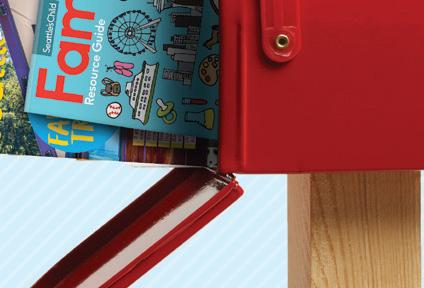








But you don’t need a needle to use very lethal drugs. Fentanyl comes in the form of a pill, and often, people have a lower perception of the risk with pills. They are very cheap and very readily available. We might have had three fentanyl-related overdoses a year in King County in the past. [Last] year, we had well over 1,000 people die from fentanyl.





SC: How many of those were kids under 18?
Finegood: From 2015 to 2018, we lost an average of three teens annually in King County. In 2022, 21 teens died of overdose. In 2023, 16 teens died.
SC: Narcan is now available over the counter. Do you have Narcan at home?



Finegood: As a parent, I decided it was in our best interest to stock Narcan/naloxone in the house once my kids were teenagers. It never hurts. It’s only going to hurt when you don’t have it when you need it. Naloxone has no known adverse impacts if it is used on something other than an overdose. So it is extremely low-risk.
I can’t tell you how many parents I’ve talked to after their kids have died who said, ‘If there’s one thing that I wish I would have done, it was to have naloxone in the house.’
I think it should be part of the [family medicine cabinet].
SC: What did you say to your teens when you decided to keep naloxone at
Finegood: It looks like somebody who’s really overly tired, overly sedated. If you can wake somebody up, they don’t need Narcan. But it’s also critical that you don’t let them go back to sleep. Public Health Seattle-King County has some great posters with visual graphics that help identify overdose. I can’t say enough how important it is to know what to look for and how to respond.
SC: So it’s a bad idea to just let someone “sleep it off”?
Finegood: Many parents thought that was the right idea for their kids. And unfortunately, they never woke up. If you suspect an overdose, don’t let them ‘sleep it off.’
SC: What do you say to parents who fear having Narcan condones drug use?
Finegood: We teach our kids from an early age about safe sex practices. That doesn’t necessarily condone them having early sex. If we, as parents, deny their truth, we’re pushing them further away. My kids, to the best of my knowledge, have never tried opioids, but they know what an opioid is. They know what fentanyl is. And they know how to respond to an overdose.
Sign up for mail deliv y seattleschild.com/ subscribe SEATTLESCHILD.COM good-bye city, hello farm 2 1families, home Loving co-housing YOUR KID FRIENDLYIn search of securityhousing MARCH/ Where we liveand why families, FRIENDLY 6 SEATTLE’S CHILD March/April 2024
CONTINUED
» Dad Next Door
A little encouragement from across the fence
by JEFF LEE, MD
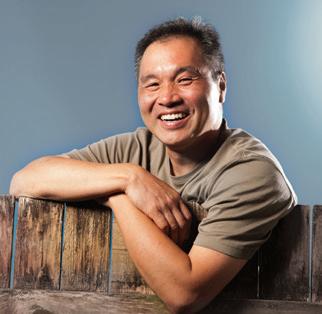
Lip-Gloss-Gate
When my oldest daughter was in sixth grade, she had the loveliest group of friends. She went to a small all-girls school, and all of her classmates seemed to be smart, funny, adorable kids. Then, in seventh grade, something went horribly wrong. Her class (which had all the same girls as the year before) erupted in drama and emotional upheaval almost from the first week of school. This culminated, after several weeks, in a crisis of hurt feelings and accusations that began with a misunderstanding over a missing container of lip gloss. Yes. Lip gloss.
What happened?
After “Lip-Gloss-Gate” was sorted out, and an uneasy peace was restored, I remember asking one of the teachers WTF had happened to the delightful girls of the previous year. She just shrugged and said: “Welcome to seventh grade.”
Apparently, this happened to every class like clockwork. Some biological clock deep inside their brains told them that this was the time to redefine themselves, and the best way to do that was in relation to each other. Suddenly they arranged themselves into cliques and alliances, and found themselves navigating a world full of misunderstandings, slights’ and betrayals. Hardly a day went by without someone dissolving into tears. She assured us that the girls would begin to settle down in a year or so. In the meantime, she recommended that we try not to get whiplash from the sudden ups, downs, and screeching hairpin turns. Just buckle up, and enjoy the ride. My own hazy memories
Looking back, my own middle school years occupy a hazy place in my brain. Mostly I just recall the feelings: anxiety, uncertainty, and a constant discomfort in my own skin. Like most of my childhood memories, the actual experiences of those years seem almost as if they happened to someone else.
My memories from just a year or two later have a different quality. I think of them as part of an unbroken line of identity that leads all the way to the present day. The person I was in high school was clearly just a younger, dumber, more energetic version of me. The person I was in middle school seems like an entirely different person.
This idea, that our pre-adolescent selves were actually not the same people
we are today, is more than a metaphor — it’s a neurodevelopmental fact. Vast areas of the cerebral cortex, and especially the prefrontal lobes which enable executive function and decision-making, undergo massive growth and rewiring during adolescence. So much of our brains are rebuilt, remodeled and added onto in those teenage years, it’s like one of those big new houses constructed on the site of a cramped little shack. The old foundation is still there, and the address doesn’t change, but it’s more like a teardown than a renovation.
Emotional roller coaster
These days, I’ve been trying to keep all of this in mind as our 13-year-old Pippa makes her way through the seventh grade. Her emotional roller coaster is in full swing these days. One moment, she’s sullen and monosyllabic, and the next she’s babbling a mile a minute about some dramatic development with her friends. She challenges everything we say or do, and resists every suggestion we make on principle — the principle being that if we think she should do something it must be part of an insidious plot to rob her of her agency and autonomy, and deny her chosen identity. Or maybe she’s just tired because she stayed up late last night. Who the hell knows?
Sigh. Buckle up. Enjoy the ride.
Is that light?
I will say, though, that halfway through this tumultuous year we’re beginning to see some light at the end of the tunnel. Sometimes, between the wild swings of self-absorption, reactivity, obstinance and withdrawal, there are these little moments of awareness and connection. Out of nowhere, she might turn to us and express gratitude for something we’ve done, or confide in us about something that’s on her mind. It’s a little awkward — like a new AI program trying to figure out how to act like a human — but she’s trying. You can almost see her remodeled prefrontal cortex taking shape, one brick at a time. In those moments, I start to see glimpses of the adult she’s in the process of becoming, and it’s someone I’m looking forward to getting to know.
Soon. Please, let it be soon.
ABOUT OUR COLUMNIST
Jeff Lee is still trying to figure out how to act like a human, in Seattle, WA






















Sign up for our email newsle s seattleschild.com/ subscribe Your guide to a kidfriendly city deliv ed to y r inb March/April 2024 SEATTLE’S CHILD 7
„ Read all of Jeff Lee’s columns on seattleschild.com
»ToolBox
What every parent needs to have on hand
What is my kid’s poop telling me?
A parent’s guide to kid bowel movements
by DR. SUSANNA BLOCK
Let’s face it, parenting comes with dealing with poop. It’s just one of the facts of parent life. While there are some kids, especially toddlers in toilet training, who are fascinated with poop, I get questions from parents all the time about their kid’s stool. One of the most common questions I get is, “What’s going on with my child’s poop?” Today we’ll talk all things poop and get to the bottom of it. What is poop?

Your child’s gastrointestinal (GI) tract’s main function is to break down food and absorb nutrients and fluids. The work of the GI tract has an impact on growth, the immune system and development. Stool can be affected by many things including type of food, exercise, stress, infections, food allergies and underlying medical disorders.
What is normal poop?
Should my child go poop every day?
Like many things in life, what is normal for one person may be different than what is normal for someone else. Some children poop 1-2 times per day and others poop every few days. The most important thing is the softness of the poop. The goal is to have stool that is soft, pain free and without abdominal pain.
What color should poop be?
I do get a lot of questions about poop color. Poop color can be affected by what foods are eaten, how fast food is moving through the digestive system, child’s age, and illness. Stool that is white, black or red is concerning and needs to be further evaluated by a doctor. Generally, stool that is yellow, brown or green in a happy and well child is simply a reflection of what has been eaten.
Newborns are their own special entities in every way and have their own stool story. Infants in the first few days of life pass black, sticky stool called meconium. Breastfed infants have soft mustard yellow-seedy stool and may poop anywhere from one time every three days to 8 to 12 times per day. Once puree or solid foods are introduced, stool turns brown and is less frequent.
What is functional constipation?
Functional constipation is the most common type of constipation and occurs when

children hold back their bowel movements. Stool withholding behavior can happen when children are too busy to stop and use the toilet, are afraid that it will hurt, do not like to stool in public toilets, after a stomach infection or simply because they are trying to take control around potty training. For whatever reason, stool withholding behavior can lead to abdominal pain and cramps and nausea, and decrease appetite and increase anxiety around stooling.
If stool withholding goes on for a long time, it can lead to encopresis which is stool backup leading to dilation of the bowel and overflow diarrhea. If you are worried your child has encopresis, it’s important to talk to your doctor for treatment.
What is organic constipation?
Organic constipation is constipation secondary to a medical problem. It is very rare compared to functional constipation and has a variety of reasons including celiac disease or thyroid disease.
Is my baby constipated?
Babies can look very alarming when they are pooping, they often get red in the face and cry. Combine this with the fact that babies can poop multiple times a day to once every two to three days, it’s natural to wonder if they are constipated. For babies over one month of age who have hard stools or seem very uncomfortable it may be reasonable to try a small amount of prune juice. The rule of thumb is one ounce a day for every month of life up to about four months (a three-month-old baby would get three ounces). Once babies are taking purees it is reasonable to give them prune or fruit puree.
What are signs of constipation?
• Abdominal pain and cramps
• Decrease appetite
• Hard painful stools
• Anal fissure- small tears in the skin around the rectum and anus from passing a hard stool.
• Fecal streaking
Constipation treatment for kids
• Increase dietary fiber: It’s always a good idea to make sure your child is taking enough natural fiber from fruits, vegetables and other high-fiber foods.
• Stay hydrated: If the body does not get enough water, it will pull fluid from the intestines making stool harder and leading to constipation.
• Change in toilet posture: Some children have slumpy posture on the toilet. One way to improve toilet posture is with a potty stool which improves toileting posture by relaxing the muscles and straightening the anorectal angle to make pooping easier.
• Being active: Being active and moving helps everything, including preventing constipation.
If you’ve tried this and your child still has signs of constipation, it makes sense to go to your medical provider to talk about next steps.
ABOUT OUR COLUMNIST
Dr. Susanna Block, MD, MPH, is a pediatrician with Kaiser Permanente in Seattle and lives with her family in Queen Anne.
SPONSORED BY

8 SEATTLE’S CHILD March/April 2024 TOOLBOX: COURTESY OF SHUTTERSTOCK
SPONSORED CONTENT
„ Subscribe to the Romp newsletter seattleschild.com/newsletter

Escape from Seattle Desert fun in Palm Springs
Looking for warm weather and plenty of sunshine? Spring is the perfect time to visit California’s Palm Springs. Our family loved Margaritaville Resort, with its colorful decor and Miami Beach vibe, and the city’s street art, sculptures, and indigenous culture. Feeling adventurous? The rotating Palm Springs Aerial Tramway ascends 8,516 feet. At the top a restaurant, museum, and plenty of hiking at Mount San Jacinto Park await. Don’t miss the Living Desert Zoo and Gardens and Joshua Tree National Park, a backdrop to early Star Trek episodes, is an hour away. See our full Palm Springs itinerary at 3seattleschild.com —Jasmin Thankachen
»Romp
Things to do with kids

The Moisture Festival
Celebrating 20 wonderful, weird, creative years
by TIFFANY GUERZON
2024 marks the 20th anniversary of the Moisture Festival Comedy/Varieté in Seattle. Despite having been around for two decades, many still don’t know exactly what Moisture Festival is. Is it a circus? Or is it a musical, dance, magic, or comedy show? Yes.
It’s all the above… and so much more.
Moisture Festival, which runs from March 21 to April 14, is the largest comedy/varieté (variety) festival in the world. With roots in vaudeville, varieté, and comedy, it is truly hard to describe. You’ve got to experience it.
Montana von Fliss, a longtime
festival volunteer, has been bringing her children to shows since they were young. “Not only do my kids want to go every year, but they want to bring their friends,” von Fliss says. “As soon as we see one show, they want to go back and see another.” Her kids love the fact that the performers often mingle with audience members after the
It’s time to plan spring and summer fun and getaways. Theme parks can be an awfully thrilling way to greet those seasons. Here are some PNW gems.
Federal Way
Wild Waves Theme & Water Park
Wild Waves is the grand dame Washington water park — it boasts a wave pool, a whole bunch of water slides, thrill rides, slower-paced kid rides, and more. Open May 18-November 3.
2
Salem, Oregon Enchanted Forest
5 things to do Awesome amusement parks 3
In this forest, storybook fantasy and history come together for a “quirky and cute” full-family fun experience. Open weekends in April and May-June 13; daily June 14-Labor Day; weekends in September.
Portland, Oregon Oaks Amusement Park
Opened in 1905, Oaks offers 24 attractions, including a steel roller coaster, a historical carousel, and other vintage park pieces. The roller rink may be the largest in a U.S. theme park. Main season, March 23-September 2.
1 4
Athol, Idaho Silverwood Theme Park
It’s the largest PNW theme park with seven roller coasters and far, far more. Make it a weekend. Open May 4-September 22.
Vancouver, B.C.
Playland
Amusement Park
Be one of the first riders on the new electric launch coaster ThunderVolt. Open May-August. Tickets must be purchased in advance.
—Kaiya DeCory-Keen
March/April 2024 SEATTLE’S CHILD 9
CONTINUED ON NEXT PAGE > MOISTURE FESTIVAL: COURTESY OF SANDERLING PHOTOGRAPHY ESCAPE FROM SEATTLE: COURTESY OF SHUTTERSTOCK
Aerialist Kari Jay Hunter wows the audience with her performance.
5
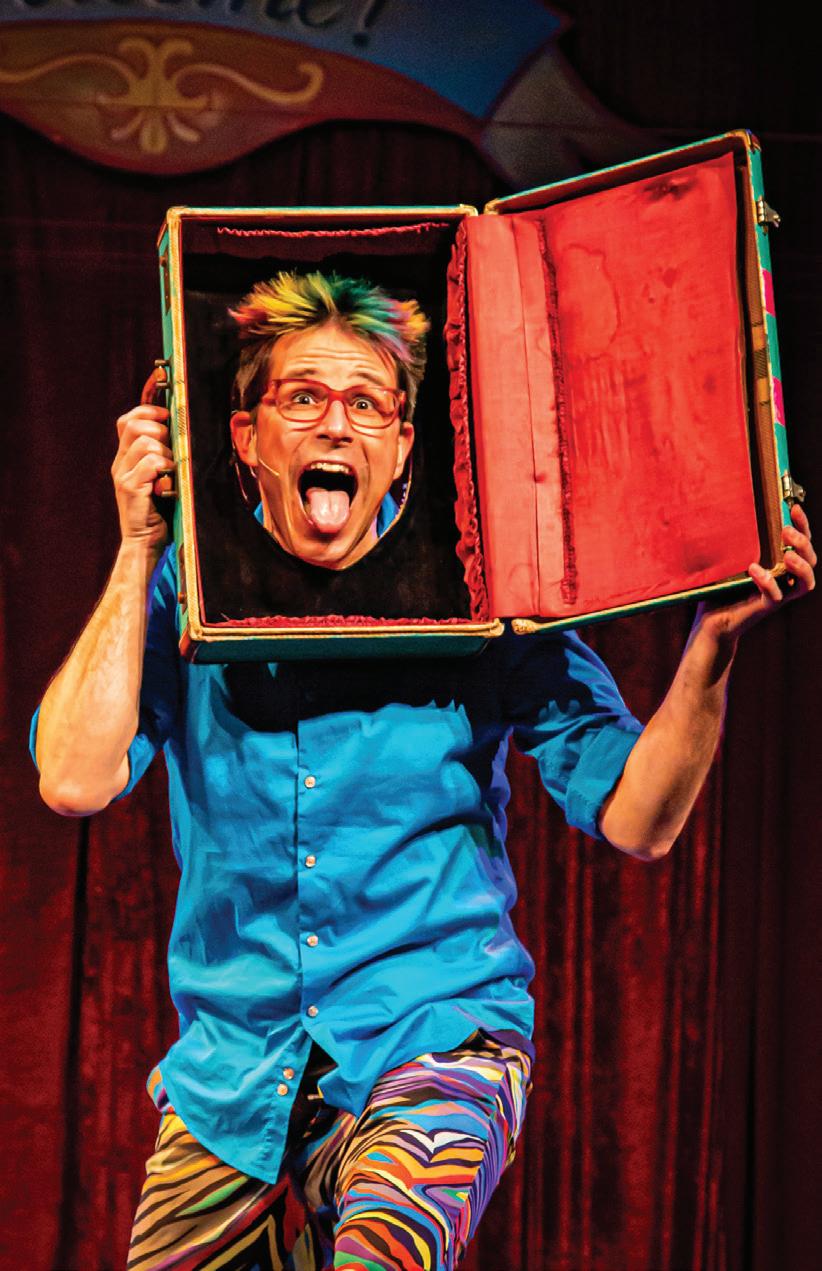
«Romp
show. “They went up to the Bubble Guy, and he not only did a couple of tricks just for them but taught them a trick too.”
Moisture Festival Artistic Director Ron W. Bailey, a musician who spent time playing at Pike Place Market and the Oregon Country Fair, says he enjoyed the connection he felt with audiences in such up-close, outdoor scenes. He loved that the audience was invited to loosen up and join in on the fun. After attending a comedy/varieté fest in Berlin, where he experienced a similar audience/performer connection, he wanted to bring this unique entertainment to Seattle.
The name Moisture Festival came about when Ron and his wife were driving and saw a sign that read “Oyster Festival.” When his wife mistakenly thought the sign said Moisture Festival, he laughed and asked, “What the heck is a moisture festival?”
The group that would later become founders of the fest, Tim Furst of the Flying Karamazov Brothers, Maque DaVis, Simon Neale, and Sandy Palmer

PEPS offers peer-support programs for expectant parents, parents of newborns, infants, or adolescents and teens, plus affinity groups. Families can connect on weekdays and weeknights in virtual and in-person groups.
of the Fremont Players, were already brainstorming names having to do with rain. Moisture Festival decided it.
The first show was held in a tent in Fremont and only lasted three nights. Now the festival runs for four weeks every year. The company is a nonprofit, and performers are paid via a “share” system. Aerialist Jessica Perry says that although the show pays less, it makes up for that in perks. For example, performers can stay in the homes of volunteers.
“Instead of being put up in a stuffy hotel, you stay with locals who love the festival,” Perry says. “It’s a soul-filling gig.”
The community culture continues backstage. Performers mingle with volunteers, eating a communal meal together each day.
Perry says, “But at the [Moisture Festival] everyone is on equal footing; they’ve done a really good job at creating that culture.”
“The Green Room is its own little circus,” said Katherine Bragdon, a longtime volunteer. “There will be a person juggling, a contortionist stretching, and The Bubble Guy doing tricks, mixed in with volunteers and their kids.”
Over the years, more people have become involved.
“It really has gone beyond the founders; the festival has become a true community gathering spot,” says Bailey. “And so many of the people involved are ‘worker bees’ rolling up their sleeves and doing whatever needs to be done. It is a joy to behold.”
Each 90-minute show features a fast-paced assortment of short (less than 10-minute) acts accompanied by a live show band. Presented as a variety show, an emcee introduces each act. The show is different every night and runs from highly skilled circus acts such as aerialists and acrobats to clowns, prop comics, musicians, comedians, and more — often bizarre and usually humorous.
“You go from the awe of seeing an aerialist perform to a guy making a sandwich with his feet,” Bragdon says. “If you don’t like an act, just wait a minute.”
The fast pace, variety, and humor are what makes the show fun for all ages. “In this day and age, it’s hard to find something so joyful and pure,” says Bragdon.
Bailey says that his favorite part of the fest is seeing multiple generations enjoying the show and laughing together.




Fittingly, the festival motto is “Laughter is the key.”
See the line-up and get tickets at 3moisturefestival.org
Find support, connection, and resources for your family! Join a PEPS Group today!
Find support, connection, and resources for your family! PEPS offers peer-support programs for expectant parents, parents of newborns, infants, or adolescents and teens, plus affinity groups. Families can connect on weekdays and weeknights in virtual and in-person groups. Join a PEPS Group today! Flexible Pricing program fees and financial assistance are available for all groups. Flexible Pricing program fees and Financial Assistance available for all groups. 10 SEATTLE’S CHILD March/April 2024
CONTINUED
MOISTURE FESTIVAL: COURTESY OF ROBERT FALK
Alex Zerbe, the Zaniac, is a Seattle native and was voted the Pacific Northwest’s Funniest Prop Comic.

Doesn’t that scare you?
When I tell people that my daughter is a flying trapeze artist and aerialist, they usually say, “Doesn’t that scare you?”
Here’s what I answer: She’s been preparing me for this all her life.
As a child, she was all impulse and energy. She climbed tall objects, jumped from high places and, at age two, I caught her on top of the fridge. Childproofing only slowed her down. After she did a cartwheel down the stairs and was miraculously unhurt, we put her into gymnastics in the hopes that she would learn to control her growing body — and to fall safely.
No one was surprised when she decided (at age 18) to become a flying trapeze and circus artist. In her first professional job, she learned the “Spanish web.” In this act, performers hang from a long rope via loops by their hands or ankles, doing tricks, often upside down, up to 30 feet in the air — while spinning. Flying trapeze didn’t scare me, but Spanish web was the manifestation of my worst fear: of her falling and breaking her neck.
Then one day she showed me the rigging that she hangs from, explaining the safety mechanisms. As she described the type of rope used and how much weight the carabiner can hold at an angle while spinning, I felt my shoulders relax.
I realized that while her career can be dangerous, she is doing everything she can to keep herself safe. Not only in her rigging but also by training her body for the sport. Although I still feel my stomach clench when I watch her spinning high in the air, I know that she’s no longer that reckless child leaping before looking.
—Tiffany Guerzon













Scan for Things To Do Your guide to find fun! seattleschild.com March/April 2024 SEATTLE’S CHILD 11
MOISTURE FESTIVAL: COURTESY OF TIFFANY GUERZON
Find

Sail Away to Victoria, BC
cohoferry.com
877-386-2202
packages@blackball.com
101 East Railroad Ave., Port Angeles, WA 98362
Black Ball Ferry Line operates the MV Coho 90-minute vehicle and passenger ferry between Port Angeles, WA — a scenic drive from Seattle — and the Inner Harbour of downtown Victoria, BC.
Save big on a family vacation with curated travel packages by combining your ferry with a hotel stay and popular attractions in Victoria, BC. Receive unbeatable value and free parking at some of the region’s top hotels.
Plus, children under 12 sail and stay for free when you book a hotel package!

A Very Sunriver Spring
sunriverresort.com
855-420-8206
info@sunriver-resort.com Bend, OR
Gear up for a truly unforgettable spring at Sunriver Resort that will have the family reminiscing for years. There is something for everyone in the family. Explore 40+ miles of paved scenic bike trails, splash the day away at the Cove, stargaze in the Backyard, practice your golf swing, and best of all savor delectable meals together. With so many exciting activities to choose from, Sunriver Resort is the ultimate destination. Book your stay today and start planning your adventurepacked itinerary.
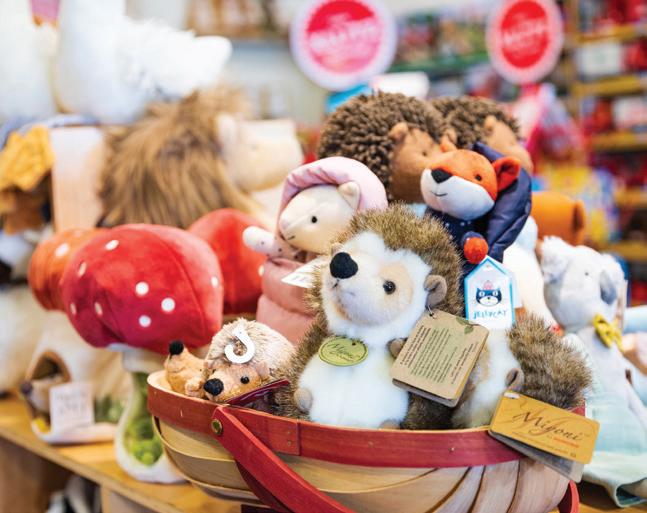
Clover Toys
clovertoys.com
206-782-0715
4609 14th Ave NW, Ste 103, Seattle, WA 98107
Explore the enchanting world of Clover Toys, nestled in Seattle’s Ballard neighborhood. Delight in handmade wooden animals, imaginative playthings, and engaging kits for budding artists, builders, and scientists. Discover cozy blankets, adorable rattles, and developmental toys for babies and toddlers. Our new Ballard Blocks location awaits your visit, offering a wide array of timeless treasures to spark joy and creativity in every child’s heart.

Tacoma Rainiers
TacomaRainiers.com
253-752-7707
Cheney Stadium
2502 S Tyler St., Tacoma, WA 98405
Looking for an iconic baseball experience in the South Sound? Visit Cheney Stadium in Tacoma, WA, where you can catch the future stars of the Mariners in an intimate setting that ensures everyone is close to the action. Whether you’re cheering for the home team or soaking in the atmosphere, the stage is set for fun, laughter, and the timeless magic of Triple-A Baseball.
12 SEATTLE’S CHILD March/April 2024 Paid Advertising
12 March/April 2024 Paid Advertising Section

Food Fun
Sushi with a song
A singing robot. That’s one way to get kids to love a visit to a sushi restaurant. Not to mention Sushi Hana’s unique “monorail system” for delivering food to the table, its rice ball-making machine, and its automated rice-sheet maker for technology lovers. If you go, introduce yourselves to Peanut, the restaurant’s drink-delivering robot. Peanut is likely to sing you a tune as she stops at or speeds by your table. All of that — the super fresh sushi and other menu items, the automated ordering and delivery, and the crooning Peanut — make for a fun and tasty family dine-out experience. Located in Bothell or Lynnwood. Most dishes run between $4.50 and $8.15. — Cheryl Murfin
»Chomp
Eating with kids

Lessons from an Italian table
Chef Mauro Golmarvi on kids’ palates, manners and more
by CHERYL MURFIN / photograph by JOSHUA HUSTON
Before my grandmother Julie left us to greet the holy pasta maker in the sky, sitting at the table for long meals that turned into games that turned into meandering conversations that eventually turned into dessert was the norm for the Italian side of my family.
Dinners at Grandma’s house or with her out at a restaurant might go on for hours. Even so, we kids, for the most part, stayed seated, didn’t complain, participated in the play, ate what the adults ate, and, if we got bored, quietly gathered at the end of the table to play. Tantrums were unheard of.
Turns out this is The Italian Way. In her 2008 book “La Bella Vita: Daily Inspiration from Italy,” author Helen Ruchti summed up Italian family mealtime perfectly: “That’s where kids,” she says, “learn all the family stories and secrets of neighbors and friends. They learn to talk and listen simultaneously; to talk loud enough to be heard. They learn the joy of being with family and the value of a lazy Sunday
CONTINUED ON NEXT PAGE >
New in Town
Healthy eats at Sweetgreen
Want a trick for making kids eager to eat green?
Turn it into fast food. Doing that is what LA-based Sweetgreen has made its reputation on. The restaurant is known for its simple, seasonal, healthy salads and grain bowls, each item made in-house from scratch, using whole produce delivered the same day dishes are sold. Luckily, Sweetgreen is now open in Totem Lake (11900 NE Village Plaza, Suite 164, Kirkland). Did we mention they’ve got truly healthy kids’ plates ($8.95) sure to entice even the pickiest eaters?
One sure bet: Sweet potato fries. Expect Sweetgreen to open soon on Capital Hill and at South Lake Union.
—Cheryl Murfin

March/April 2024 SEATTLE’S CHILD 13 FOOD FUN: COURTESY OF SUSHI HANA NEW IN TOWN: COURTESY OF SWEETGREEN
More on feeding your family on seattleschild.com
Mauro Golmarvi, founder and longtime chef at Seattle’s Assaggio Ristorante, and daughter Francesca.
„
«Chomp
CONTINUED
afternoon.”
Having been to Italy many times, I’ve witnessed this scenario time and again. Italian kids enjoy eating out and seem to innately know how to act.
This all made me wonder what lessons American families might take from their Italian parent compatriots 5,000-plus miles away. I turned to a local pro, Mauro Golmarvi, for answers. Golmarvi was the founder and longtime chef at Seattle’s Assaggio Ristorante. The award-winning restaurant celebrated its 30th anniversary in 2023.
“The table is the most sacrosanct place in the Italian family. You do everything at the table,” Golmarvi, born and raised in Italy, says. “From a young age your grandma is sitting next to you and explaining everything: ‘This how you eat a mussel, this how you behave, this how we use the fork.”
Not so long ago, Golmarvi’s daughter Francesca stepped up to take over the family restaurant, another Italian tradition. Here are Mauro Golmarvi’s thoughts on kids, the family table, and dining out with kids.
Seattle’s Child (SC): What do you think of making special food for kids – or asking the chef to prepare it?
Mauro Golmarvi: This is one thing that is very different in Italy. If you don’t like the food that was prepared for the table, then tough luck. From eight years old, my daughter knew how to eat clams, anchovies and oysters. I’m her teacher. My job is to help her train her palate. We don’t give different choices at my table. I’m not going to make the peanut butter and jelly sandwich. That is not the Italian way. There, kids learn to eat all foods and spices and learn how to enjoy them.
SC: How do you build a child’s palate?
Mauro Golmarvi: From a very young age, kids must be taught to test and taste everything. In Italy, we tell our children, ‘You are going to like this, you’ll see.” We set a positive expectation. We don’t say, ‘If you don’t like this, you can have another thing.’ If they don’t like a taste, we say, ‘Try it again; let me show you how to eat this.’
SC: Is it common for restaurants in Italy to offer kid menus?
Mauro Golmarvi: Absolutely not! In Italy, that doesn’t exist there. Here, everywhere I go, I see for kids there’s only macaroni and cheese or french fries. They don’t learn to grow their palate from this.
SC: Do you see a difference in kids’ behaviors between the two countries?
Tips for parents
Restauranteur Mauro Golmarvi offers these tips to parents who want to enjoy eating out with kids.
• Make developing a child’s palate a priority. At a minimum, they should be expected to taste every item on the table. “I like this idea of ‘the polite bite,’ Golmarvi says. Reluctant? Use affirming words: “Take a bite, you will like it.”
“Let’s try it a different way.”
• Teach table manners from the moment a child starts solid foods. Wipe a baby’s face and their tray or table immediately so they start to associate eating with this expectation.
• Act swiftly when a child misbehaves. Walk them out of the establishment. When they calm down, return.
• Don’t make special foods. For that
Mauro Golmarvi: Manners and sitting at the table are very big things in Italy, the most important part of the values. Parents will not let a kid throw things on the floor and make a mess, not even the babies. When you are a baby, [parents] are constantly cleaning off your mouth and teaching you manners. From a very young age, they are showing you how to sit at the table. Every child knows how to set the table and participates that way. It’s a big difference. From a young age, they are learning how to listen, how not to interrupt, how to be comfortable with the chaos of a loud restaurant, and how to enjoy it.”
SC: What happens when a child starts to fall apart in a restaurant in Italy?
Mauro Golmarvi: Italy is a small country, unlike here, where we have the biggest spaces. Every table in Italy is right next [inches sometimes] to each other. If a child is misbehaving, one parent will always get up fast, take the child outside for a walk, and not come back until they are calm. For kids, adults, and grandparents, is about coexisting in Italy. You have to know how to manage your space. The cul tural expectation is that they allow other people to eat in peace. It’s all about co-existing in Italy, and it’s the parent’s job to ensure everybody else is not being bothered by their child. It’s not about the kid, it’s about parents taking the time to teach and teach.
SC: How is that different from what you’ve seen and experienced here
case, “In Italy, we always have bread and olive oil on the table,” Galmarvi says.
• Pasta’s here. No talking! Italian kids are taught never to talk when pasta is served so everyone at the table can enjoy it at its best level of softness.
• Practice eating out with lunch. In Italy, dinners often go on for hours and may extend past a child’s bedtime. Don’t set them up for failure.
• Teach kids to set the table and participate in cooking: It elevates the importance of the meal and setting. Cooking teaches a love of food and gets kids invested in tasting.
in Seattle?
Mauro Golmarvi: My restaurant has been in Seattle for 30 years and is well known. It’s a classy place. I really tried to make everybody happy — the kids and the customers and the business people and everybody. But it’s sometimes very hard when parents don’t manage kids.
One time, a child was really out of control, and I went to the parent and said, ‘Can we do anything for your child? Can I bring some crayons?’ She called me prejudiced. She said, ‘You’re a very hard, cold-hearted person telling me my kid is misbehaving!’
SC: Does managing kids mean they must be super quiet when dining out?
Mauro Golmarvi: No, no. I’m from a country where eating out is always a celebration. To me, that noise is happiness, it’s bustling, it’s family and joy. You go to the restaurant to be celebrated. Otherwise, you can stay home and cook. Set expectations for kids.

14 SEATTLE’S CHILD March/April 2024
CHOMP: COURTESY OF SHUTTERSTOCK










At Swanky Scoop, our ice cream cakes are making memories. Each festive cake is handmade in our shop with our indulgent flavors. Always allergy-aware, we also offer vegan and gluten-free cakes that are uncompromisingly delicious. Learn how you can make your birthday extraordinary at www.swankyscoop.com/birthdays WASHINGTON’S PREMIER MARQUEE RENTAL SUPPLIER Contact us today to light up your next event! 3FT LETTERS AND SYMBOLS • 4FT NUMBERS • SETUP AND DELIVERY INCLUDED alphalitseattle @alphalitseattle ALPHALITSEATTLE.COM // »Party! „ For even more local reseources go to seattleschild.com/directories Join the party! Subscribe to our free newsletters and we’ll keep you informed about all the latest and greatest places to go with kids in the Puget Sound area! » seattleschild.com/subscribe Your guide to kid-friendly celebrations around Puget Sound It’s time to celebrate! Planning a birthday, family gathering or fun event with friends? Check out these party places that help entertain the children and take care of all the little details. Make your event a special day to remember. Paid Advertising Section March/April 2024 SEATTLE’S CHILD 15





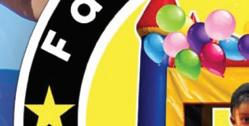
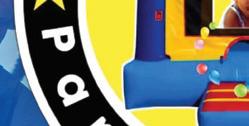



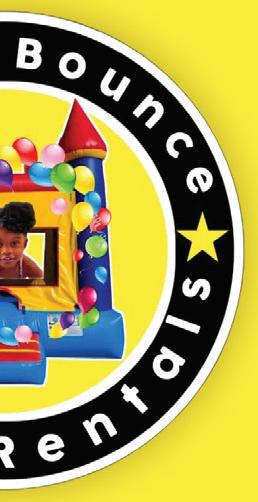

Alpha-Lit Seattle
alphalitseattle@gmail.com
alphalitseattle.com
Alpha-Lit Seattle is Washington’s premier marquee letter rental company for all your events. Our rentals include setup and deliveryso leave the stress to us. With a full inventory of letters, symbols, and numbers, we offer numerous options to customize your display for that extra WOW factor. We are a small, locally-owned and operated family business, and 100% of our inventory is American-made.




Big Air Trampoline Park
All ages
1101 Outlet Collection Way SW, Suite 1275, Auburn 98001 253-943-6770
bigairusa.com/auburn
Big Air Auburn, located inside FieldHouse USA at The Outlet Collection Seattle, features 40+ attractions, including indoor rock climbing walls, trampoline dodgeball, racing zip lines, Battlebeam®, Orbit, Valo Jump, and more! Big Air Auburn is the perfect choice for families and groups of all sizes to jump, party, play and create memories.
Brainy Actz Escape Rooms
All ages
2345 Tacoma Ave. S, Tacoma 98402 253-442-9815
contactus@brainyactzsocal.com
brainyactzescaperooms.com/ tacoma-wa
We are the perfect Tacoma venue for your next birthday event. With a spacious lobby, convenient location, and rooms that encourage communication, critical thinking and teamwork, Brainy Actz Escape Room provides an experience that your party will love. No matter the size of your group, Brainy Actz Escape Room can accommodate your needs.
Choose your package AFFORDABLE. CLEAN. RELIABLE. faithsbouncepartyrentals.com Birthday themed Toddler Soft Play Princess Summer Fun Spider-Man Game Time Movie Night ...and more! Reserve your BOUNCE package today!
ILLUSTRATIONS COURTESY OF SHUTTERSTOCK 16 SEATTLE’S CHILD March/April 2024 Paid Advertising Section
Crossroads Bellevue
15600 NE 8th St., Bellevue 98008 425-644-1111
info@crossroadsbellevue.com crossroadsbellevue.com
Crossroads Bellevue is your destination for birthday fun. Choose from exciting party destinations, including Creatively Yours Ceramic Studio, Snip-Its Kids Salon, The Studio Fine Art Classes, WiggleWorks Kids, and more. Plus find decorations, ice cream, cake and gifts all in one stop.
Faith’s Bounce Party Rentals
Ages 1-16
206-717-5230
info@faithsbouncehouserentals.com
faithsbouncepartyrentals.com
We are a family-owned and -operated Bouncy House and Party Rentals company. We are licensed and insured and double our due diligence in cleaning and sanitizing all items. We cover several of your party needs, from bouncy houses to soft play, tables, chairs and games. We can save you time setting up your decorations.
FrogLegs Culinary
Ages 3-Adult
Locations in Seattle, Redmond and Kirkland
206-887-8229
info@froglegskca.com
froglegskca.com
FrogLegs creates magical events; making your birthday extra special! Our ingredients for success start with our amazing teachers, beautiful kitchens, delicious menus, hands-on approach and themed decorations… in other words, we do it all. Birthdays are important and that’s why we go the extra mile to make FrogLegs the Hoppiest Place on Earth. Parties for kids to adults too!


Offering fun, hands-on geology programs for kids of all ages. Educational programs are mobile - the experience comes to you!
ROCKS • MINERALS • FOSSILS • SUMMER CAMPS • FIELD TRIPS
ROCKS • MINERALS • FOSSILS • STEM ENRICHMENT • BIRTHDAY PARTIES ROCKSOLIDSCIENCE.COM
ROCKS • MINERALS • FOSSILS • BIRTHDAY PARTIES • SUMMER CAMPS • STEM ENRICHMENT ROCKSOLIDSCIENCE.COM | 206.715.2556


Paid Advertising Section March/April 2024 SEATTLE’S CHILD 17






Monster Mini Golf
All Ages
Factoria Mall Marketplace
4080 Factoria Sq. Mall SE, Bellevue 98006
425-679-6265
bellevue@monsterminigolf.com
monsterminigolf.com/bellevue
Monster Mini Golf birthday parties are unlike any other birthday party you have ever experienced. Your child will be the star of the event and the center of attention on their big day! It features a glow-in-the-dark mini-golf course with fun monsters, upbeat music, and a live DJ, followed by a world-class arcade including mini bowling, a laser maze, and virtual reality. Fun for everyone!
Pacific Science Center
Ages 2-18
200 2nd Ave. N, Seattle 98109 206-443-2001
venues@pacsci.org
pacificsciencecenter.org/ visit/birthday-parties
PacSci birthday party packages include a variety of fun and educational hands-on activities to ignite curiosity in all ages. When the festivities are over, your party can spend the rest of the day exploring interactive exhibits. Packages include a private room, a coordinator, and a 10-minute science-themed experience.

Pump It Up
Ages 2-12
11605 NE 116th St., Kirkland 98034 18027 Highway 99, Suite J, Lynnwood 98037
425-820-2297 (Kirkland) 425-774-2297 (Lynnwood) wa.kirkland@pumpitupparty.com pumpitupparty.com/seattlebirthday-parties
Pump It Up is the premier indoor destination for every occasion: birthdays, field trips, open jump, playgroups, camps, team parties, fundraisers and more. All our parties are 100% private and feature giant inflatables and other fun attractions to keep all the kids engaged and excited. We also offer fun party experiences like Glow and Bubble Blast that you won’t find at other venues, and our
Be Quick. Be Clever. Be Brave. ESCAPE ROOMS | TACOMA (253) 422-9815 | BRAINYACTZESCAPEROOMS.COM/TACOMA-WA You’re invited to a real-life 60-minute puzzle adventure.
ILLUSTRATION COURTESY OF SHUTTERSTOCK 18 SEATTLE’S CHILD March/April 2024 Paid Advertising Section Explore your options or submit an inquiry at pacsci.org.


reserve the arcade...
get the entire venue to yourself for 2 hours Includes Unlimited Free Play of All arcade games. no quarters. no hidden fees
for up to 30 guests
for up to 60 guests $199 additional hour
any food from outside easy online booking amazing party host choose your music Reserve now at waterlandarcade.com 22306 Marine View Dr. S Des Moines, WA
Arcade is one of the top destinations in the greater seattle area for parties for all ages!
online booking using this QR code:
...and
$449
$599
bring
Waterland
easy











monthly Family Jump Nights are always popular. Hope to see you soon!
Rock Solid Science
Ages 6-12
Edmonds, WA 206-715-2556
info@rocksolidscience.com
rocksolidscience.com
Does your child love rocks and minerals? Have you considered a geology-themed party? Discover the exciting world of gems and geology with a Rock-Solid party experience that comes to you. Embark on an adventure with touch tables, crack open geodes, marvel at real Minecraft minerals, and much more! Learn more at rocksolidscience.com.
Swanky Scoop
All ages
13550 NE Village Square Drive, Unit 1030, Woodinville 98072 425-659-3534
info@swankyscoop.com
swankyscoop.com/birthdays
Celebrate with unique artisan ice cream cakes from Swanky Scoop. Our cakes are custom-made in our shop with our indulgent flavors plus your classic favorites. Always allergy-aware, we also offer vegan and gluten-free cakes that are uncompromisingly delicious. Let us help make your birthday extraordinary!
Waterland Arcade
All Ages
22306 Marine View Dr. S, Des Moines 98198
206-653-7679
jason@waterlandarcade.com
waterlandarcade.com
Waterland Arcade guarantees an exciting and budget-friendly experience for the whole family. Every party package includes unlimited free play of over 60 games, including arcade classics, brand-new arcade releases, and family favorites like skee ball, air hockey, and basketball. Located near the water in the beautiful Marina District of Des Moines. Book your party using our online portal today.


Paid Advertising Section March/April 2024 SEATTLE’S CHILD 21
ILLUSTRATION COURTESY OF SHUTTERSTOCK
Where we

22 SEATTLE’S CHILD March/April 2024
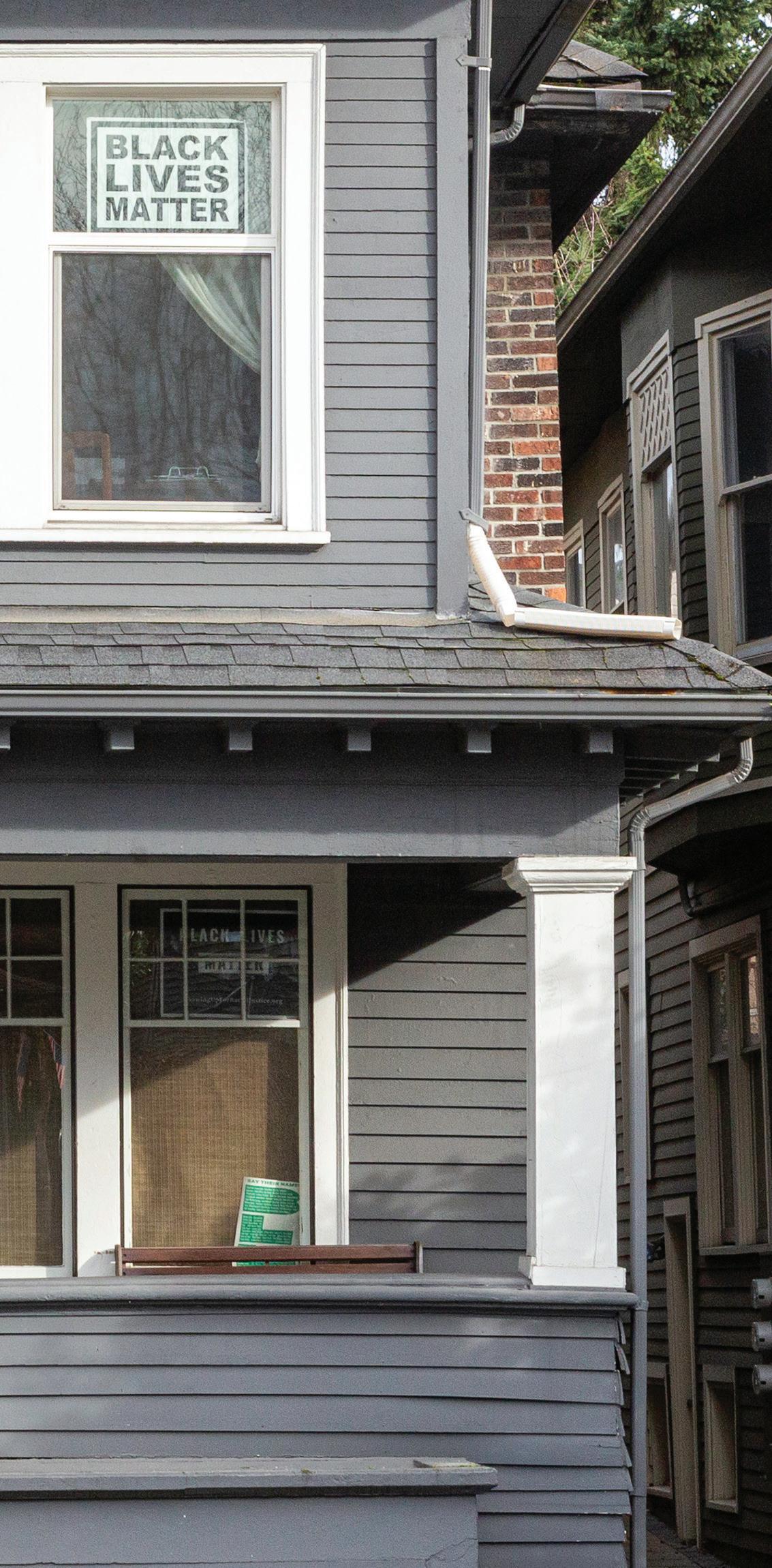
In this issue, we feature 10 families that represent a vast range of living situations — some based on necessity due to the pandemic, economy, or other challenges, others based on choice. Some parents in this section have opted for unconventional scenarios that allow them to cut housing expenses. Others sought to escape the pull of the status quo or prioritize their values. In some cases, parents are dedicated to having their ideals and lifestyle inform how and where they live. And there are families here who have fewer housing options until they reach greater financial and employment stability. In the meantime, they are working within their means.
All of these parents share something in common, however. Each seeks to build a loving, stable home — however that may look — for their children.
One home,
two families
A way to buy despite limited income
by ELIZABETH HUNTER / photograph by JOSHUA HUSTON
“
The kids always knock before they go in, but they absolutely love their ‘Titi’ Jessica. We usually eat together at least once a week, and we see each other almost every day.”
That’s Sarah Stuteville, a mental health counselor and mom of two, talking about her best friend Jessica Partnow, who co-owns the nearly 3,500-square-foot Central District home Sarah and her husband, Alex Stonehill, purchased in 2009.
Jessica and her husband, Kurtiss, live downstairs; Sarah, Alex, and their kids live upstairs. They all own the property together — Sarah and Alex 60%, Jessica and Kurtiss 40%.
CONTINUED ON PAGE 24 >
March/April 2024 SEATTLE’S CHILD 23
live
Kurtiss and Jessica Partnow live downstairs and Alex and Sarah Stuteville and their kids live upstairs with a tenancy in common agreement.
« One home, two families
CONTINUED FROM PAGE 23
They have been co-owners since 2021.
As housing becomes more unaffordable, families in the greater Seattle area have adapted. One such adaptation is shared homeownership. While most shared ownership agreements are between multigenerational families or tech workers (think HBO’s “Silicon Valley”), sharing the cost of a home with trusted friends is an attractive alternative to, say, paying $200,000 for a down payment.
Tenancy-in-common (TIC) agreements allow two or more individuals to own a property together. Right now, with the median home price in Seattle almost double the national median, and with mortgage rates the highest in decades, sharing a home may appeal to families who have been squeezed out of the market.
In a TIC, each owner has an undivided interest in the entire property regardless of how much of the property they own. Everyone is responsible for maintenance and repairs.
At the Stuteville-Stonehill-Partnow residence, each family manages issues specific to their space, but they split the cost of utilities, repairs, and taxes. “We are like family,” says Alex, “so it’s not really a negotiation. We just trust each other.”
Like a family, Jessica and Kurtiss provide “an extra set of hands,” according to Sarah, in raising the kids, Malcolm, 8, and Hellenore, 5. The children have learned how to live in community as a result of the arrangement. Hellenore says she likes the chance to “do a mission, like take Titi and Kurtiss olive oil when they’re cooking.”
“Sarah, Alex and I have been friends and business partners in so many ways over the years,” says Jessica. “All of those years, building our trust and friendship has made owning a house together feel like the most natural thing in the world.”
The friendships formed by this tight trio became a lifeline when crisis struck.
In 2020, Jessca and Kurtiss were house hunting when Kurtiss suffered a stroke. Hopes of owning a home were dashed. Kurtiss would need a living space to accommodate a wheelchair, and his care took precedence over other expenditures.
This could have been the end of the couple’s dream of homeownership. Instead, it was the start of something amazing.
Together, Sarah, Alex, Kurtiss, and Jessica came up with a plan. Jessica and Kurtiss would buy into the residence, purchasing 40% of the property. The couples renovated the first floor to accommodate Kurtiss’s wheelchair.
“Kurtiss’s stroke really showed us why building a community is so important,” says Jessica. “If we were on our own, I have no idea where we’d be living.”
Sarah and Alex have rented out space in the home ever since they purchased it, so the kids are accustomed to living in a multi-family residence. They pop downstairs for snacks, and Jessica and Kurtiss will often let a babysitter leave early and keep a baby monitor downstairs when Sarah and Alex are out.
The children are also smitten with Uncle Kurtiss’s service dog, Queso.
“They are really good with Queso. They learned right away he’s only allowed to play when he’s ‘off duty,’” says Jessica.
Most difficulties the families encountered came from outside the home.
“We struggled to find a lawyer who understood what we wanted,” Sarah says, “and everybody thought we were crazy.”
Zach Burr, a property lawyer with Burrwood Law Group, hasn’t negotiated many TICs or shared homeownership agreements for separate families. He said more families are building Accessory Dwelling Units (ADUs), like backyard cottages, which they can then rent out or sell off. But for the most part, ADUs are a separate living space entirely.
“There are definitely financial benefits to sharing a home, but you have to take into account the social issues,” says Zach. “Adding people to your home isn’t stress-free.” He recommends drawing up a community guidelines agreement to which each owner can adhere.
For his part, Alex doesn’t understand reticence toward shared homeownership.
“You enter into an agreement like this when you buy a house with the person you marry,” says Alex. “Why do we trust that immediately, but not our friends?”
An extra set of hands at the ready? Support through life’s curveballs? Enjoying a meal with your best friend every week?
That doesn’t sound crazy at all.

Living a ‘beautiful chaos’
by JOAN KING photograph by JOSHUA HUSTON
Dusty Wall and Greg Nance met sailing the seas — the pirate seas, to be exact. In 2020, the two men noticed each other on a “Sea of Thieves” livestream channel and immediately befriended one another. Sea of Thieves, for the uninitiated, is a shared-world digital adventure game.
Greg is married to Tiffany and has two kids and usually played Thieves with his wife until that point. So, in a natural progression of their friendship, Greg introduced Dusty to Tiffany.
An unconventional decision
This is where the story becomes slightly less conventional: Tiffany and Dusty really hit it off. Eventually, they and Greg agreed to enter into a polyamorous relationship and become a polycule: Three or more people connected romantically. Dusty became Tiffany’s romantic partner while Tiffany remained married to Greg. Dusty, his wife
24 SEATTLE’S CHILD March/April 2024 Whe r e we l i v e
The Wall-Nance-Trembath clan enjoys full group activities at either house.
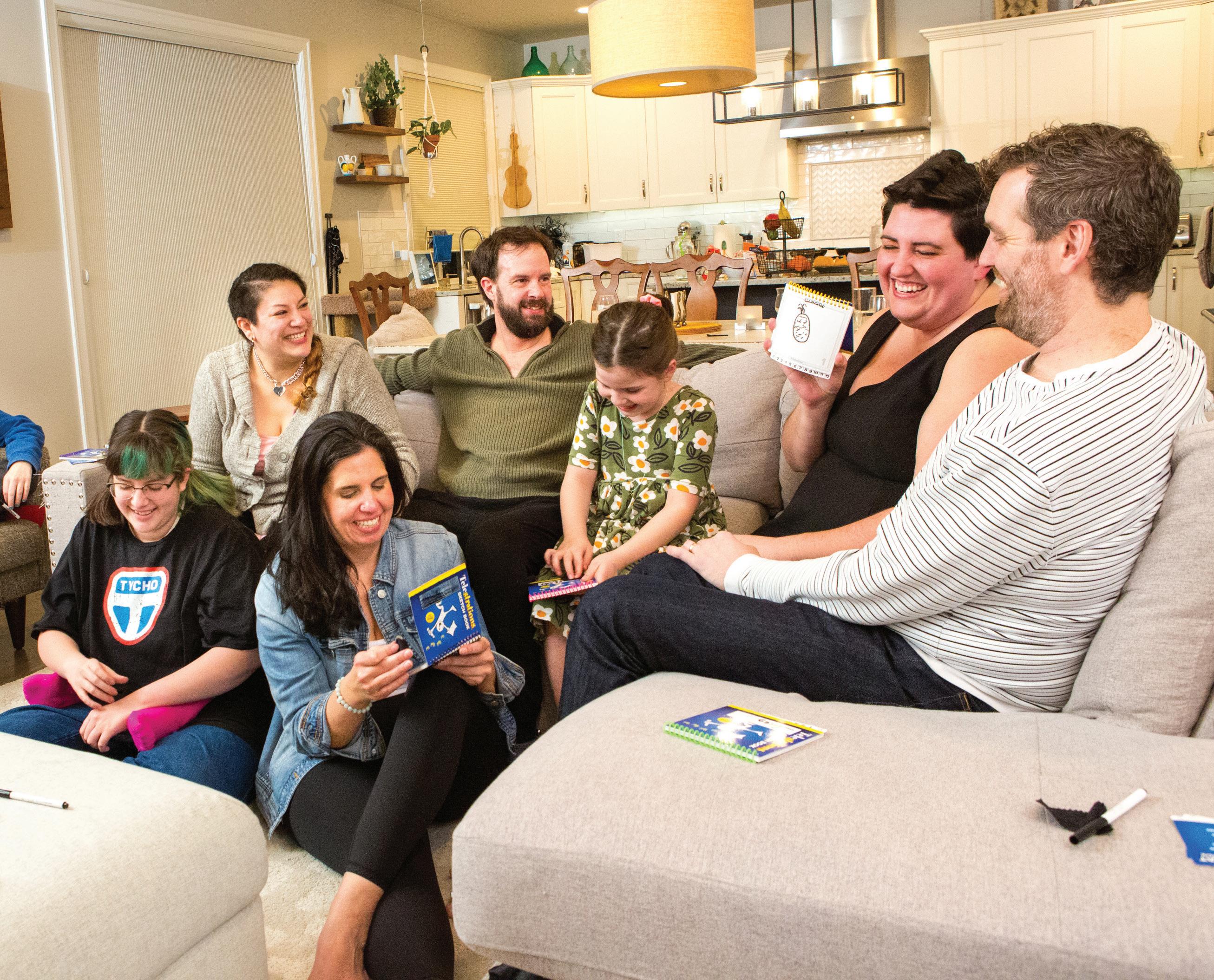
April, and their two kids moved to Washington from the California Bay area to nurture and support the polycule.
How it works
Logistically, there are two primary residences in this polycule. The couples shuttle between the homes. That means, at times, Tiffany and Greg spend the evening cooking together at the Nances’ house in Issaquah. At other times, Dusty and Tiffany spend time together at the Walls’ house in Tacoma. You will also find Greg spending time with his romantic partner Tasha Trembath, at the Nances’ house.
Greg and Trembath met in 2021. In private practice as a marriage and family therapist, Trembath currently lives in the Nance house. Following her and Greg’s decision to extend the polycule and in the midst of skyrocketing housing costs, Trembath moved in last year.
Greg describes the two-family polycule in two words: “Beautiful chaos.” The families
The close-knit
polycule
share multiple calendars to track all the kids’ various activities, including sports practices, dance, and saxophone lessons. The calendars include the adult responsible for pickup on any given day.
How parenting works
The Nance children include 12-year-old Kat and 7-year-old Reyna, while the Wall children include 12-year-old Jamie and 14-year-old Moo. Each adult member of the polycule participates in parenting in a symphony of coordination.
Like any parents or guardians, they rely on each other and show up to as many of the childrens’ extracurricular activities as possible. The Nance children sleep at the Nance house while the Wall children sleep at the Wall house, although they occasionally hold joint family sleepovers. Trembath attends as many activities as her schedule allows and is fully incorporated into the family.
Beyond attending events, all adults also participate in parenting the children: “Our
kids are lucky and have a lot of parents in their ears all the time,” says Greg.
Dusty says one of his favorite aspects of the polycule is the four kids spending time together. The families get together as much as possible for activities such as mini golf. The five adults of the polycule enthusiastically nod their heads when they collectively list the various sporting events, concerts, and recitals where the children will show up to support one another.
What the kids say
When the parents broke the news to the children, the children surprisingly didn’t have much to say. Greg credits their reaction primarily to the straightforward way the adults navigated the conversation:
“I think a big part of that is not ever having sat the kids down for a big talk about how things are going to change. It was pretty matter of fact: ‘Mom and Dad love other
CONTINUED ON PAGE 26 >
March/April 2024 SEATTLE’S CHILD 25
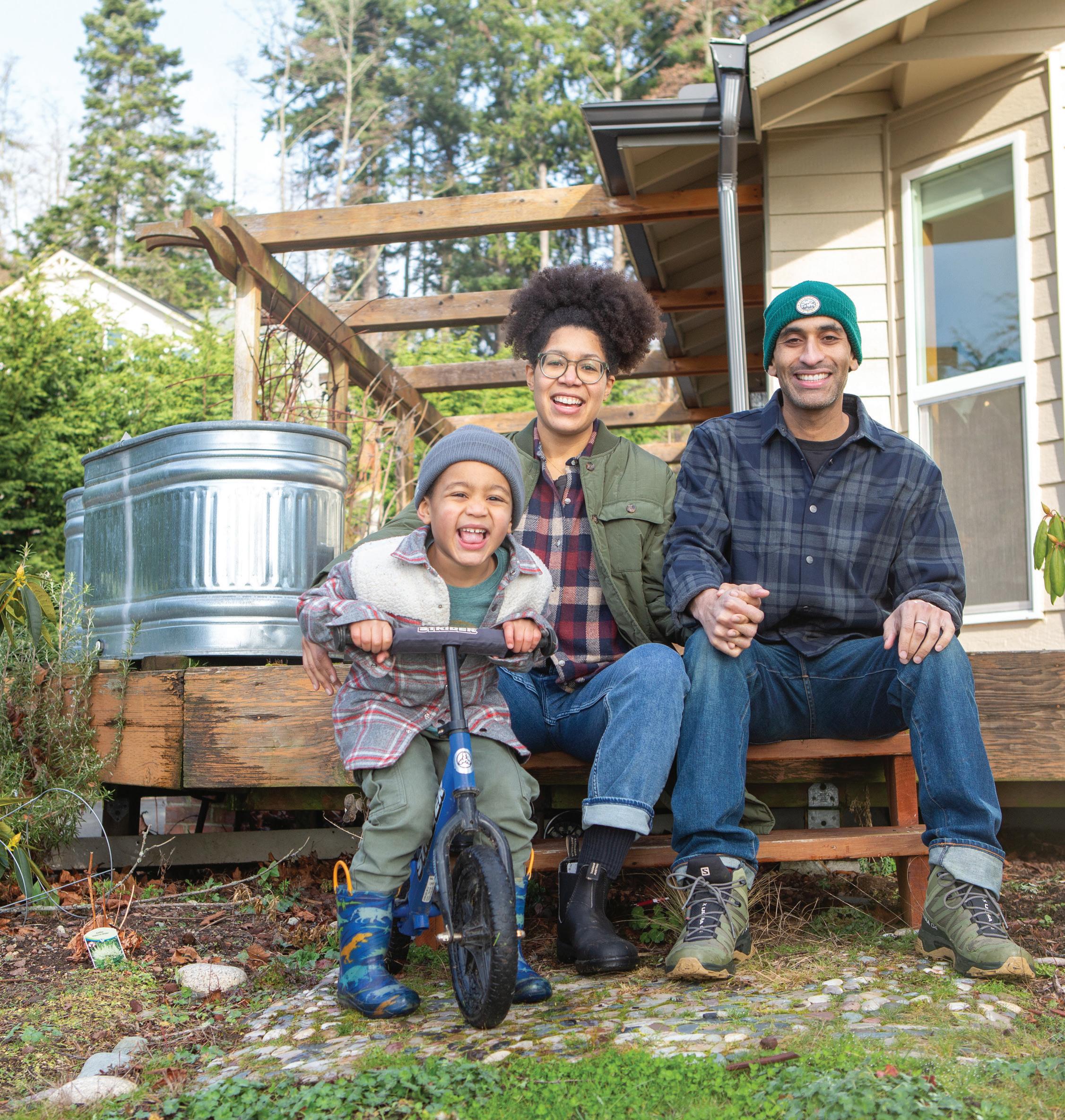
« The close-knit polycule
CONTINUED FROM PAGE 25
people, and you’re going to start seeing expressions of that love in our family.’ We were very intentional about the language that we used, keeping it age-appropriate while still being very direct. They honestly didn’t have
a lot of questions about it.”
Moo’s response to the question of how she likes the setup was likewise direct: “It’s fun because I have a second family and we all get to go hang out. And anytime we get to do something, I’m like, ‘Are the Nances coming?’ Because it’s ten times more fun if they do.”
The children are accustomed to being
part of a large family dynamic. As Kat points out, “Sometimes it’s sad and there’s literally no one in the house. Most of the time, it’s fun because the more, the merrier.”
Finding space
The couples manage to find time with their romantic partners no matter which house they choose to stay at for the night.
26 SEATTLE’S CHILD March/April 2024
Whe r e we l i v e
Hillarie Maddox and Udie Chima with their youngest son at their Whidbey Island house.

Good-bye city, hello country
Exposing kids to ‘more possibilities of how to live’
by MELODY IP photograph by JOSHUA HUSTON
Growing up in rural South Dakota, Hillarie Maddox dreamt of living in the city. As an adult, she did just that, matching the professional aspirations and lifestyle of those around her. Her husband, Udie Chima, grew up in Seattle and always saw himself as a “city person.”
In 2020, the couple and their first child were living with Chima’s parents in Wallingford while saving money to buy property outside the city. When COVID hit, they reevaluated their goals, which altered the trajectory of their lives.
“We both started feeling really claustrophobic, and it didn’t help that we were living with my parents,” Chima says. “But it didn’t feel like we could go back to how things were. We wanted to get out of the cycle, the same sights and sounds, to form our own way.”
They began scoping out towns and properties, seeking acreage, greenery, and racial diversity. The week they bought their current house on Whidbey Island, they found out Maddox was expecting their second child.
Not having grown up with much time in nature, Maddox is grateful that her kids — now ages 2 and 5 — are exposed to more possibilities of how to live. With distance from her corporate past, Maddox recognizes the disconnect many of us have with the earth and our bodies, and the unsustainability of goals like promotions, wealth, and travel.
These realizations led Maddox to trade in her laptop for gardening tools.
Dusty explains, “We have shared space [at my house in Tacoma]. When I go over to the Nances, I’m staying with Tiffany. [In Tacoma], we have a bedroom downstairs where Tiffany and I can stay. We have some pretty nice living arrangements in our two houses, going back and forth. And we host things where the whole polycule comes over as
She quit her job at Amazon to homeschool her children and invest in the local agricultural community. She began growing vegetables, and the family’s yard now features native landscaping and food forests.
“It started with spending time in nature and letting the kids see where their food comes from,” Maddox says. “That alone is really world-shifting.”
Maddox started a farm collective with other local women — some are farmers, others are creative business owners. It is a primary source of community and education for her family.
“We want our kids to be included in whatever we do, so we bring them to the farm,” Maddox says. “We have meetings, potlucks, get-togethers, and our kids are always a part of that. It’s not directly earth-tending, but it allows them to see that we’re having these conversations about what it means to be inclusive with our kids. What does it mean to create communities that support each other? That’s really powerful for them.”
Maddox also started Black Girl Country Living, which offers workshops, podcasts, and coaching to others who resonate with the family’s values. Her Instagram account (@blackgirl. countryliving) covers gardening, mental health, parenting, social justice, and more — and how they all intersect.
But even with nature as their playground and healing space, Maddox and Chima do miss some aspects of city life.
“The museums, for sure,” Maddox says. “There’s always so much happening on the weekends [in Seattle] and there are so many good parks. It’s taken a lot more effort to find other moms and kids who I want to raise my kids around, who have shared values. … Even more so, finding other families
well at either house. And that’s always nice.”
While polycule relationships don’t always result in co-housing, the Nances, Walls and Trembath say it makes sense for them and boils down to two factors: time and finances.
From three to two to one
The polycule used to have three res-
of color has been challenging, so I’ve put in a lot of effort driving down to the BIPOC community center on the south end of the island.”
Maddox also misses Seattle shopping and pastries, but the trade-offs have been worth it.
“Learning to find something I enjoy has been the greatest payoff, and being able to find ways of working with my family on different creative projects,” says Maddox. “I don’t think that would have ever happened if we were still in the city.”
Chima agrees that the personal sacrifices are worthwhile, even though he misses Seattle’s music scene and the ease of getting together with friends and family in the city.
However, “[the move] has opened up a lot of possibility in terms of what we can do with our time and our careers,” says Chima, who works full-time and remotely as a UX designer. “Moving out here and the quiet that came with it has made me more in tune with how I want to spend my time because you don’t have as many interruptions. It’s just quieter in the evenings, and you can reflect.”
“It started with spending time in nature and letting kids see where their food comes from. That alone is really worldshifting.”
Hillarie Maddox
Since moving, Chima has started a podcast about music, Sound Dialect, and has become more active in online music communities while dreaming bigger about his role in those spaces. Maddox feels more grounded in the earth and inspires others — including her children — to pursue more sustainable lifestyles. Their kids are experiencing the healing powers of nature. They are growing up with the wind in their hair and their hands in the dirt.
idences before downsizing to two. Their goal is to have all the adults and kids in one residence. But finding the right house is challenging: With many adults comes many social-emotional needs.
“I’m an introvert” says Trembath. “It can be hard when there are so many people and there’s not a space [for] quiet time.”
March/April 2024 SEATTLE’S CHILD 27

The way home
Finding housing security after a child care crisis
by JOAN KING photograph by JOSHUA HUSTON
After speaking with Ariel Tarawally for a few minutes, one thing is evident: She is a survivor.
In 2019, Tarawally found herself in an unthinkable situation: She and her kids (ages 8 and 9 at the time) faced homelessness after she lost her job.
Before the COVID pandemic, Tarawally, a single mom, relied on Boys & Girls Club childcare services to cover her kids while she worked. Her son has autism and requires specific care and attention. However, lower staffing during the pandemic meant Linus could not get the individualized care he needed.
While her employer had been understanding of Tarawally’s unique child care situation when she was initially employed, they eventually told her they could no longer provide flexible work accommodations. In May 2019, Tarawally was let go. Unable to pay rent, she, Linus, and her daughter Pandora ended up at Mary’s Place, the region’s
central shelter program and wrap-around support provider for unhoused families. The family remained in the shelter for 66 days.
Tarawally says of her child care and housing challenges: “Our situation requires unique parameters for us to work. And it’s not stable. Maybe I can stay with a company for almost a year until something happens with my child. Maybe too many times I have to leave early to do something for him.”
Dominique Alex, CEO of Mary’s Place, says Tarawally’s child care conundrum is not uncommon.
“The lack of affordable high-quality child care impacts a family’s ability to work and pay rent, or even where they choose to live,” Alex says. “It’s one of the most challenging barriers to helping families move back into stable housing.”
With the help and support of Mary’s Place, Tarawally and her kids found permanent stable housing in August 2019. To get there, the nonprofit organization paired Tarawally with a housing advocate who provided support while she navigated finding the right place. The organization also helped with moving costs.
Now ages 12 and 13, Pandora and Linus can be left home unsupervised for longer periods of time. And that makes parenting
while working full-time a little easier for Tarawally. She feels as though she is making progress in what she calls her “tax credit apartment” in Kirkland — a building close to her work and from which it is more difficult to be evicted.
The years spent cycling through doubt, child care concerns and related employment issues still haunt Tarawally.
When she returned to work post-pandemic, Tarawally turned to the club’s child care services once more since staffing levels had returned to normal. Unfortunately, concerns arose about her son’s care that Tarawally could not ignore. She found herself spinning in circles to solve her child care challenge.
Although she’s been in stable housing for more than four years, she can’t help but worry about long-term housing security.
“Even though I have basic milestones that consider someone an adult, like job, car, place, all those things are highly conditional in our situation,” she says.
That unease is understandable. Now that Tarawally, a college graduate, makes $25 an hour, she no longer qualifies for food stamps. This single change in income is a significant contributing factor to Tarawally’s accumulating debt. Still, Tarawally’s tenacity keeps
28 SEATTLE’S CHILD March/April 2024
Whe r e we l i v e
Ariel Tarawally and her kids Linus and Pandora in their “tax credit apartment.”
her going. Even as she worries about putting food on the table, her positive attitude feeds her hope for a bright future for her family.
“In order for me to stay motivated, stay proactive, and have some hope and belief that I can somehow create a better situation, I have to do some form of reinvention every time things happen,” she says.
Tarawally credits her daughter with the family’s transition from unhoused to stability. Because Pandora cares for her brother with a disability, Tarawally is able to continue her full-time employment and avoid being let go.
Still, “mom guilt” weighs heavily on Tarawally. She worries that her heavy reliance on Pandora will have long-term repercussions, and she regrets that her daughter was forced to step into a role that she may not have been ready for — all for the sake of staying housed.
With her finances and housing relatively stable, Tarawally lives on hope.
She is proud that her children do not feel the effects of her financial struggles and that she is able to meet all her family’s basic needs.
“By any definition, we’re poor. But my children really aren’t feeling it. And that’s my only credit,” she says. “It’s that I make a lot happen for them with what little I have.”
111%
436,000
779,200
84,857
The
3 0,00 0 +
Annual number of students who experience homelessness in Washington
WASHINGTON OFFICE OF SUPERINTENDENT OF PUBLIC INSTRUCTION
45%
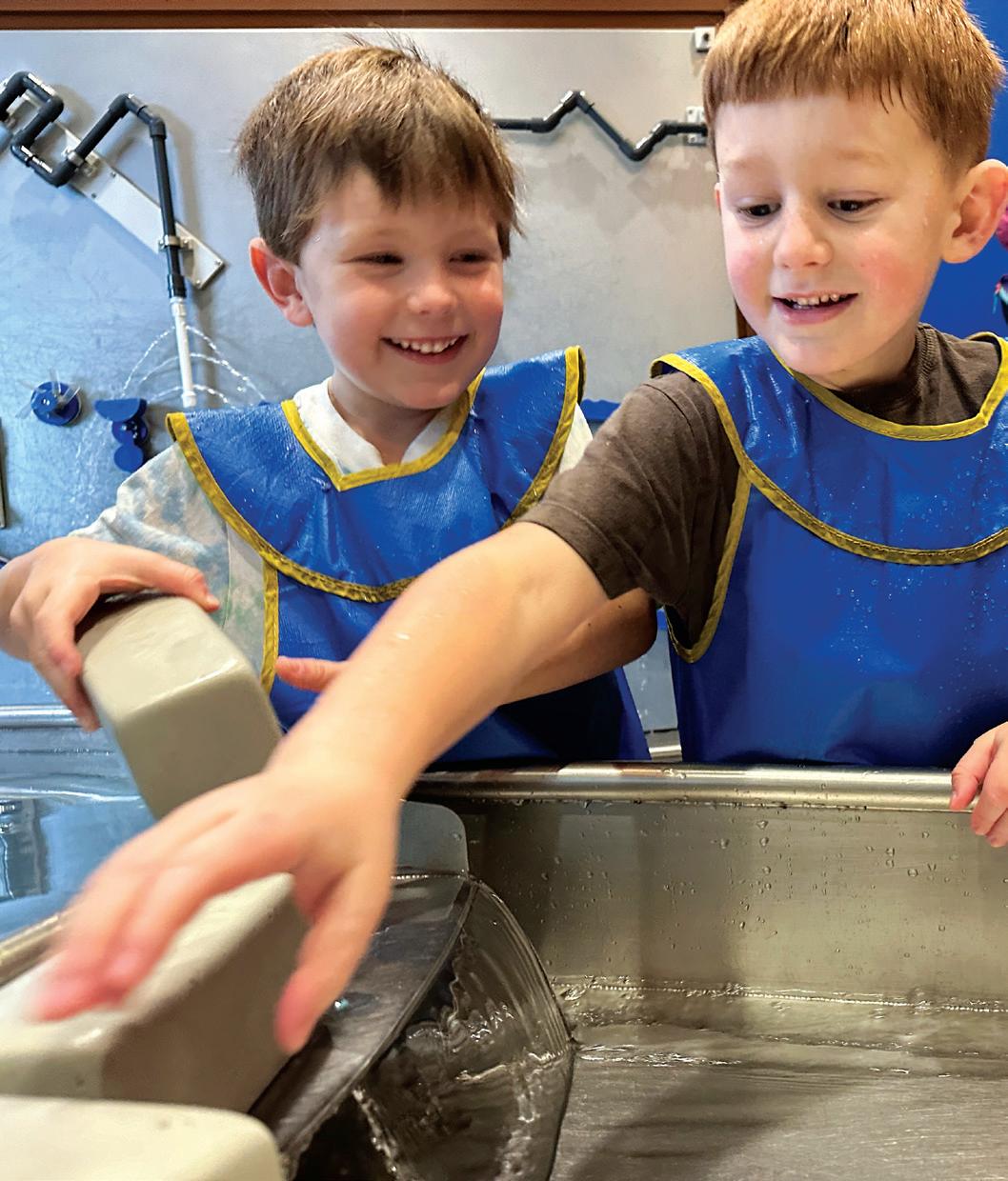
A 501(C)(3) non-profit organization. KidsQuestMuseum.org Free & discounted tickets available Play with PASSION! Let your spirit be wild at KidsQuest! Join us in Bellevue and experience the power of PLAY! March/April 2024 SEATTLE’S CHILD 29
Where we live
national
PAYSCALE.COM
Seattle housing costs percentage higher than the
average
BUREAU OF CENSUS
The number of children in King County went down 20,000 between 2020 and 2022 U.S.
more
WASHINGTON STATE OFFICE OF FINANCIAL MANAGEMENT
City of Seattle population, an increase of
than 155,000 in 10 years
FINANCIAL MANAGEMENT
number of housing units added to the Seattle market between 2013 and 2023 WASHINGTON STATE OFFICE OF
Percentage of Seattle homes that are owned by the family living in them WASHINGTON STATE OFFICE OF FINANCIAL MANAGEMENT
Buying our first home with ARCH
A boost for lower-income first-time buyers
by JOAN KING
When I was a little girl, I thought a house with stairs was a sign of great success.
Growing up the child of Korean immigrants, there was nothing more I yearned for. And there was nothing I was more ashamed of than my small one-story house in Renton, located in a neighborhood other kids called ‘the ghetto’ or ‘the hood’ back in the early ‘90s.
Of course, by the time I was an adult, there was nothing I would have loved more than a house in my childhood neighborhood.
Unfortunately, when I returned to Renton after several years in the military, I was faced with a shocking fact: I could not afford a house in the neighborhood I grew up in. Rapid gentrification meant the small, cinder-block houses that were a source of shame grow ing up were now beyond my means. The irony doesn’t escape me.
a child, we couldn’t even afford Christmas lights.
My husband and I are both Air Force veterans. I am grateful to the military for providing me with a chance to find financial stability and for its generous educational benefits. But there are a lot of misconceptions about Veterans Administration (VA) benefits and housing. For example, a lot of people tout our access to VA home loans, where a vet can purchase a home for zero percent down. It’s a great benefit, but it doesn’t address the monster of a mortgage payment veteran home buyers face since there is no down payment to alleviate monthly payments.

Beyond wanting to raise my children in a property we owned, I’d seen the sacrifices that my parents made to move to this country. For me, owning a home was the epitome of success and fulfilled the American Dream. Since then, I’ve become more disillusioned with that dream, which values meritocracy over equity when it comes to housing. But, when I gave birth to my son in 2013, my primary goal was to own a home to shield my son from the misguided shame I felt as a child, a place where I could curate Christmas traditions I missed as a child. When I was


The truth is that it is still best to put money down. Despite the “benefit” we were entitled to, my husband and I were discouraged and wondered if owning was even a possibility.
We moved to Washington in 2014 and stayed at my mother’s home while we hunted for a house, wondering how we would afford a home without a massive down payment. That’s when I came across a 1,200-square-foot condominium listing that claimed to be an ‘ARCH home.’ After some Googling and speaking to my realtor, I learned that A Regional Coalition for Housing (ARCH) provides affordable housing throughout King County for first-time homeowners who qualify as “low-income.”
ARCH homes are offered for sale at affordable prices within market-rate housing developments and are available in a range of sizes, types, and price points. The organization has put properties on the market in Redmond, Kirkland, Bellevue, Newcastle, Issaquah, Sammamish, Kenmore, Woodinville,

Duvall, and unincorporated King County. Agreements made on how ARCH properties are used (covenants) help keep prices affordable long-term and ensure that they are owner-occupied (as opposed to subletting to others).
We did not hesitate to apply for the ARCH Issaquah Highlands condominium we’d found. Since my friends were paying around $2,000 to $3,000 a month for day care at the time, I wanted to stay at home with our new baby to avoid those costs. This decision ultimately made us eligible for the program’s low-income requirement. Go to the ARCH Rental Program Income and Rent Guidelines at 3archhousing.org for information on income limits.
The ARCH application process was surprisingly efficient, and we closed on the condo in approximately one month. We were shocked at the ease.
“I could not afford a house in the neighborhood I grew up in.”
Joan King
One of the contingencies of purchasing an ARCH home is that there is a cap on how much you can ask for when selling your home. After living in our condominium for six years, we decided to move into a larger home in 2018. Just then, the housing market spiked in Issaquah. When there is an exponential increase in market value, ARCH increases its listing cap.
After we requested the cap to be raised, we sold within a couple of months and profited almost $120,000 dollars. We turned around and put that profit right into a down payment in a 2,000-square-foot home in Covington. Our mortgage payment is now approximately $2,500.
We have lived in our house for about five years now. Every Christmas, I put up our tree, promising myself to one day purchase a little home in my old Renton neighborhood where my husband and I can quietly retire. I’m sure that by then our knees will be grateful for a small home — without stairs.

line seattleschild .com Check us out Summer Classes Summer Multi-Arts Camps Nurturing Baby • Caregiver-Child Creative Dance • Modern • Ballet • Hip Hop Ballet Stories • Hip Hop • Art in Motion Stories in Motion • EnviroDance Musical Theatre (Descendants, Trolls, and Willy Wonka JR.) Enroll now! creativedance.org 30 SEATTLE’S CHILD March/April 2024
Whe r e we l i v e

lives downstairs Grandma
An intergenerational family experience
by
MELODY IP
David Basior, Ariel Zaslav, and their two kids, Madrona and Gahlia (ages 12 and 9), would say that they have the ideal housemate. She’s reliable with rent, she provides childcare support, she walks the family’s dog, the kids adore her — and she’s also their grandmother.
Before Diane Beverly, Basior’s mother, moved in with the family, she lived and worked in Florida. A 2014 hip injury forced her into early retirement and left her wondering what to do next. Then came news that Basior’s family was moving from Philadelphia to Seattle for a new job.
With Seattle’s cost of living significantly higher than Philadelphia’s, Basior and Zaslav proposed an option to Beverly: What would living together in Seattle and sharing expenses look like?
For several years, the family tried different options in Seattle, including renting
a home together and living apart within the same neighborhood. In 2020, they landed in their current three-story townhome in the Central District. Beverly lives in the bottom studio, with the rest of the family occupying the top two floors. The family members regularly flow through each other’s spaces, whether Beverly is cooking in the kitchen or relaxing in the living room, or the kids are running downstairs to see grandma before heading to school.
In this multigenerational household, everyone has an opportunity to witness and welcome the perspective of another generation.
Though Beverly is a parent with many years of experience, she has become more of an observer and learner of her son and daughter-in-law’s parenting style. When their children were younger, Beverly would often defer to the parents for guidance. Now that the kids are older, she can be more honest and direct, navigating conflicts and conversations with them one-on-one rather than through the parents.
“She’s beyond respectful and is really interested in the ways that we’re parenting that are similar and different from the way she parented — and she doesn’t take the differences personally,” Zaslav says. “My 12-year-old is very opinionated, so they will definitely butt heads, but they can work through it now without needing us to coach or offer any theory about why we might do something a certain way.”
Even as they benefit from having a grandmother so close, Madrona and Gahlia are learning about the realities of aging. Although Beverly is still independent and mobile, the family is beginning to talk about how to mutually care for one another. For example, Madrona may soon officially take on the role of carrying her grandma’s laundry up and down the stairs.
“It feels useful for [the kids] to understand [aging],” Zaslav shares. “I think they sort of understand a little bit about their other grandparents, who don’t live here, but they’re not seeing it every day, so they don’t have nearly as much awareness of ways that aging is impacting them or ways that they need support.”
Beverly’s aging is a pathway for open conversations and humor. When she recently got hearing aids, the kids told her, “We didn’t even know how annoying it was that you couldn’t hear us all the time. Now you can hear us — and it’s annoying because sometimes we have to be quiet or be careful what we say around you because you can actually hear everything.”
“I’m not going to lie. Living with my partner’s mother and their lifelong dynamic — they navigate it really well.”
Ariel Zaslav
Having another adult in the household also means having both informal and formal childcare support. Given Basior’s odd work hours and Zaslav’s work/grad school demands, the extra help comes in handy. Beverly is available to pick up the kids from school, play games, or take them to the library when their parents are not.
That same benefit, however, also has its challenges. Folding a third adult into the household requires consulting someone else’s needs and schedule before plans are made. It adds another layer of communication and forces the family to stay organized. Sometimes it works seamlessly; other times, communication fails and someone is unaware of dinner guests or a doggie playdate, all of which may mean more noise and chaos.
“And I’m not going to lie — living with my partner’s mother and their lifelong dynamic — they navigate it really well, and I’m impressed a lot of the time,” laughs Zaslav. “And then there are moments where I’m, like, am I living with a teenager and his mother? I don’t think there would be any way around that — I think that’s just part of it.”
March/April 2024 SEATTLE’S CHILD 31
Madrona and Gahlia with their grandmother, Diane Beverly, a few years ago.
PHOTO COURTESY OF ARIEL ZASLAV
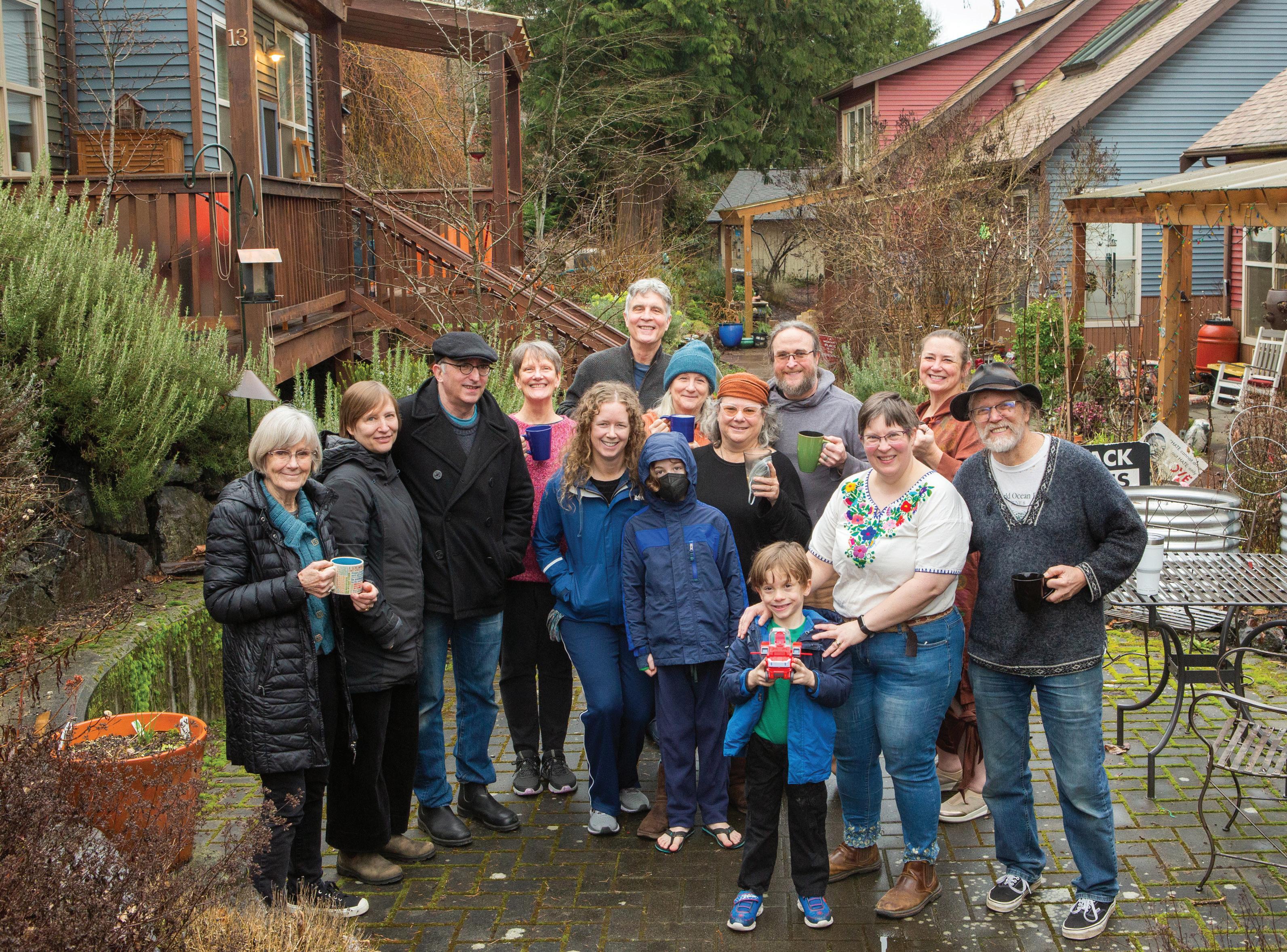
A circle of neighbors
One family’s experience living in a co-housing community
by JOAN KING
photographs by JOSHUA HUSTON
Christine Wolf’s abode feels like a 2024 version of a Norman Rockwell painting: If she needs a can of coconut milk for a recipe, she simply emails her neighbors, and multiple cans will inevitably show up on her stoop.
Wolf shares her 900-square-foot duplex with her husband, Chuck Harrison, and 7-year-old son, Jamie. And her description of her family’s community sounds downright Mayberry: Picture some neighbors chatting from their idyllic porches while others tend their gardens nearby. And the best part of living in the Duwamish Cohousing Community in West Seattle? Isolated as a community, the residents were able to socialize during the COVID lockdown.
Wolf is convinced the community felt less of the pandemic sting because each home has a porch and a garden, close enough together to stay connected and feel supported during those hard months but spaced out enough for social distancing. It was easy to chat with neighbors while still staying safe.
The desire to build community is at the heart of the co-housing development, and that goal is reflected in its design. The 23 multihouse units all face one another, their windows looking toward their neighbors’ rather than outside the community.
“There are different kids from the community they can play with. It’s kind of like having cousins.”
Christine Wolf
A central part of this co-housing development is its ‘common house.’ The larger community-owned home functions as a
shared space for everyone who lives in the development and their guests. At the same time, Wolf’s living room, like all individual homes at Duwamish Cohousing, is small — designed to encourage families to spend more time in the common house. When Wolf’s family members or others visit, she opts to use the common house so her family can enjoy their guests in a larger space. What’s it like living in such a contained space with a young child? Wolf and Harrison have found ways to maximize the family’s relatively tight quarters. By installing a secure net on the loft level of their home, they essentially created another story where their son can hang out. And while having an energetic 7-year-old may deter some
32 SEATTLE’S CHILD March/April 2024 Whe r e we l i v e
Christine Wolf and Chuck Harrison (front right) with their son and some of their Duwamish Cohousing Community neighbors.

parents from moving into a small home, Wolf says one of the many perks of her co-housing community are the relatively enclosed parameters. She doesn’t fear fast cars or her son wandering too far. A wetland lines the community on one side, so he can’t go far in that direction.
There are several children at Duwamish Cohousing. A big benefit of community living is having playmates right next door. As Wolf puts it: “There are different kids from the community they can play with. It’s kind of like having cousins.”
Wolf also feels safer parenting in a closed community where the houses face each other: As the structure encourages community, this means there are multiple sets of eyes on Jamie as he wanders the communal areas. And when adults are not outside, when the mood strikes him, he will check in on his neighbors by knocking on their doors.
Like any close-knit relationship, the community is not without its conflicts and hurdles. Wolf would not put a lack of space between neighbors on a list of co-housing cons. But she admits that if there are neighbors who aren’t getting along, there’s no place to hide in a co-housing community.
When issues do arise, however, members of the community often come together. Especially when it comes to making a decision about their property. For example, the home owners association (HOA) fees feed into the shared aspects of the property, such as the common house.
Similar to a condominium, the owners are responsible for what is inside the walls of each house, while the HOA takes care of the grounds and the outside of each building. This means deciding how the HOA fees are distributed and used are community decisions.
“We don’t have a management company that runs it,” says Wolf. “We all run it together. We’re all members of the board. We all make decisions with the consensus model, which can take a long time to do. It takes a lot of communication. We all attend the board meetings every month, and there are committee meetings.”
A major hit to the community during the pandemic was the loss of community dining in the common house, gatherings that are central in many co-housing communities. Thankfully, Wolf says, Duwamish Cohousing households are slowly returning to regular, shared meals.
Wolf wants to see more shared child care among her community members as Duwamish moves forward into the future. In fact, homeowner families are working on a rotating child care plan to allow parents to enjoy regular date nights. Jamie has a disability, which Wolf says discourages her from relying on other parents to babysit as much as she would like. But she remains hopeful for the future.
As it stands, members of this co-housing community are leaning on one another and discovering they have most of their community needs met.






















Your guide to a kidfriendly city deliv ed to y r mailb seattleschild.com/ subscribe Sign up for mail deliv y just $12/year March/April 2024 SEATTLE’S CHILD 33
Fresh Mochi :
A home, a studio, a gallery
For this artistic family, the space is everything
by
MELODY IP photograph by JOSHUA HUSTON
If you ever visit the Fresh Mochi art gallery on Beacon Hill, be sure to call in advance. Otherwise, you might catch the owners in their pajamas.
Fresh Mochi, opened in 2022 and owned by artist Elizabeth Jameson, is housed in a former grocery store that is now home to Jameson, her husband, Andy Sodt, and their 15-year-old son, Lee. Their living space consists of the art gallery, a practice space for Sodt’s band in the basement, and an adjacent
home, with a window overlooking the gallery.
“One time, a group of firemen walked in to do an inspection, and I was in my pajamas,” laughs Jameson. “They thought the building was a preschool.”
The mix-up was understandable. Shortly after Jameson and Sodt bought the property in 2001, neighborhood kids started wandering in, assuming it was a community space. Jameson began putting out paper and art supplies for them, earning the house the moniker, “The Paint House.”
“The kids would tell their parents that they were going to The Paint House, and they’d come over to hang out and work on art projects,” Jameson says. “When they were done, I would hang up their art in the windows for everyone to see.”
Prior to living there, Jameson and Sodt lived in a small house in West Seattle, and Jameson drove back and forth to a rented art studio in the International District. By day, Sodt is a computer programmer; by night, he is a musician. His bands always practiced in the basement of his residence. When the former DiCasoli corner store went on the market, the two decided it would be perfect for an artist and a musician to have their individual workspaces alongside their home. It was the ideal solution to meld their personal and professional needs, cutting down on financial responsibilities and commute times.
When 2 ½-year-old Lee joined the family in 2009, the function of the space completely changed. Toys were now common installations in the space. Lee began doodling on Jameson’s artwork, prompting the parents to put up a temporary gate while Jameson worked on an upcoming show.
As Lee grew, the space evolved. Tables displayed his LEGO brick creations, and an open space enabled Lee and his friends to let out their energy however they needed.
“There is lots of space for art projects and games like ping-pong,” Lee says. “We have a big kitchen for having weekly pasta nights, where we make homemade pasta. My friends
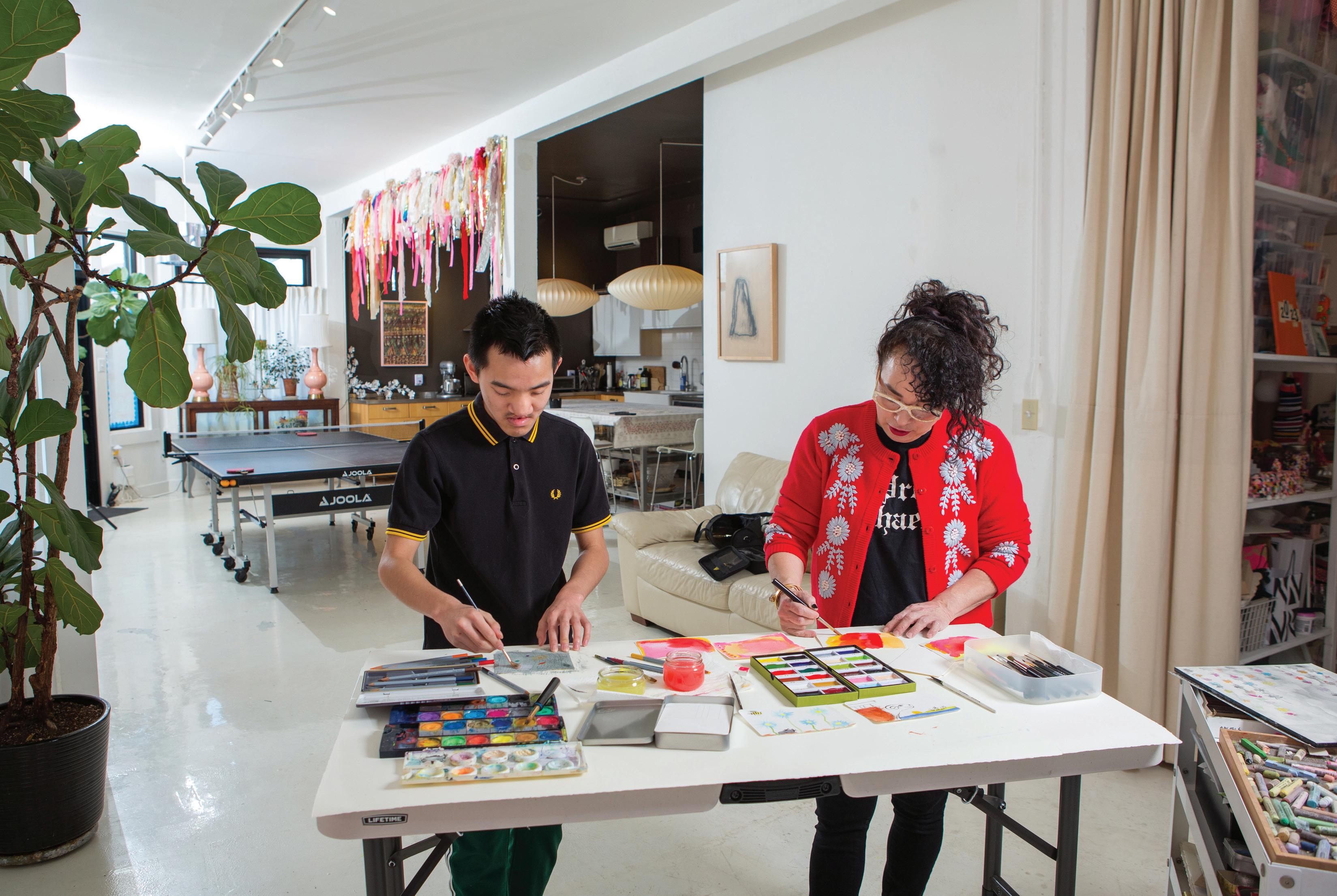
34 SEATTLE’S CHILD March/April 2024 Whe r e we l i v e
Elizabeth Jameson and son, Lee, painting art in their home and art gallery, Fresh Mochi.
think the open space is cool.”
When Lee’s friends were younger, some of them would cry when it came time to go home. And while adult friends don’t cry, they often stay long into the night in the cave-like basement, partying, commiserating, doing karaoke.
With a large space for creativity and community, however, comes the ordeal of keeping it clean and free of clutter. Before any community events, which have included gallery openings, fundraisers, and fashion shows, Jameson spends hours cleaning and getting the space ready to welcome people. “One challenge I have is vacuuming the whole floor in the studio because it’s so big,” she says.
“The kids would tell their parents that they were going to The Paint House.”
Ariel Zaslav
The family faced another challenge when the old store portion of the house was used as an Airbnb for two years.
“We were squished into a much smaller space,” Jameson remembers. “It was awkward, and we never really got used to it. We had to be quiet so as not to disturb our guests, which was almost impossible between band practices, squealing, running kids, and our love of karaoke. The guests loved staying in the art gallery-style Airbnb, though!”
But the benefits outweigh the work. The space has continued to be a great tool for building community, as it was in its days as The Paint House. During the COVID-19 lockdown, Jameson turned the storefront windows into a gallery for neighbors to enjoy. This experience and the positive responses from passersby reignited Jameson’s excitement for art, so much so that she opened the doors of her studio in March 2022 and Fresh Mochi was born.
“A lot of artists have a hard time finding a space to show their art, so I want to create a space for them here,” Jameson explains. She often collaborates with her neighbors, who also are artists who own a combined storefront and living space, to host events that bring the community together to celebrate and recognize local artists.
Fresh Mochi is open for art show openings and closings, but visitors need to contact Jameson to make appointments to view the gallery outside of these official events. Reach out to elizabeth@ejameson.com.


Your guide to a kid-friendly city. seattleschild.com/subscribe Family-friendly events, hikes, adventures, playgrounds, getaways and day trips around the Sound. Every Thursday Romp Local news and opinion related to making our community a place where all kids thrive. Every Monday Dispatch Sign up for our free weekly email newsletters. March/April 2024 SEATTLE’S CHILD 35

Living in a shoe factory turned artist co¯op
Teens enjoy industrial city and country living
by MELODY IP / photograph by JOSHUA HUSTON
The industrial setting of Georgetown, with the smells and sounds of surrounding factories and breweries, isn’t idyllic for raising kids — but that’s exactly where Jodi Brown found herself after a divorce in 2017. To make the situation even more interesting, Brown moved with her sons, Ozzie and Iggy (now 15 and 16 years old), into a former shoe factory built in 1907 and
converted into artist lofts in 1989.
From the outside, the building is a big rectangular box. Inside, five floors are divided into quadrants. Brown’s unit is a long, narrow space, measuring about 1,550 square feet, with tall ceilings — the “factory art studio vibe,” as she describes it.
“When I had the inspection done on the place, the inspector said it was as solid as a building
could be, built with cinder blocks and old factory materials.”
The building is restricted to residents with a sustained and committed art practice, so Brown — a retail designer and visual artist — was able to secure a unit after passing a rigorous vetting process.
“I would never have been able to buy this much space if it had been a traditional building,” Brown says.
“When you buy, you have to be aware that you’re not going to buy it as an investment,” Brown explains. “You’re buying it because you’re an artist, and this building is more affordable for people to have space to make art.”
When Brown’s family moved into the artists’ co-op, her sons were still splitting their time with their dad on Vashon Island, which is as different a setting from Georgetown as you could get. Living in the space felt like sleeping in a train station, with bright security lights from neighboring
buildings flooding the bedrooms and loud industrial noises. Propane tanks occasionally exploded under the nearby overpass.
“[Georgetown] feels diametrically opposed to being on Vashon, where it’s very, very quiet, and the silence almost is a presence on its own. The sounds here have their own personality,” Brown says. “[The boys] were a little bit freaked out by the neighborhood and the fact that [we lived in] an old factory building. But it’s their other home to them now.”
Brown worried that, without a yard, her kids would get bored being inside all the time. A park was within walking distance, but Brown didn’t feel comfortable sending her young kids outside on their own. Thankfully, with her sons living part time on Vashon, Brown knew they were getting ample time outdoors and with friends.
For several years, the boys would wake up early and catch the ferry to Vashon for school.
36 SEATTLE’S CHILD March/April 2024 Whe r e we l i v e

During the pandemic, online learning allowed the boys to do school from either home. But afterward, the boys balked at the early wakeup times of the pre-pandemic days, and now spend their weekdays on Vashon, with most weekends with Brown in Seattle.
Brown describes the community within the building as “somewhere between that sort of nostalgic, traditional sense of knowing your neighbor and the modern trope of the next-door stranger.” The family doesn’t spend a lot of time with their neighbors outside of the residents’ monthly gatherings, but there’s enough trust and community built in that neighbors can count on each other for support — or a cup of sugar — when needed.
The unconventional living environment “normalizes and opens [my sons’] minds to alternate ways of living, thinking, and making a living,” Brown explains. “It creates a broader landscape of feasible
CONTINUED ON PAGE 38 >
keeps this family close Small space
6 people, 3 pets, 925 sq.ft.
by MELODY IP photograph by JOSHUA HUSTON
When Dennis, Cherry, and their eldest son moved into a two-bedroom apartment in 2014, it was the perfect size for them. More than nine years later, the family has grown to six people — plus two dogs, and one axolotl. Despite that exponential growth, they’re thriving in that same small space.
Tight quarters, these parents say, have fostered flexibility and strong family bonds.
The 925-square-foot apartment in Renton was supposed to be a temporary arrangement while Cherry pursued an associate degree in nursing, which she earned in 2020. Now, Cherry is working toward a bachelor’s degree in nursing, and that means the family is staying put.
As of this writing, Cherry and Dennis, who asked to keep their last name private, were co-sleeping with 2 ½-year-old Ayvree, who had a few more weeks sharing the bed with just mom and dad before the arrival of baby #4 in February. Older brothers Aydenn (11) and Aaisic (8) share the second bedroom, though Aaisic is also reluctant to leave his parents’ room.
“He’s been struggling the most, so we went to IKEA and said, ‘Let’s just look. If having your own bed makes you excited and want to sleep in your room versus sharing a bed, let’s do that,’” Dennis says.
The family left IKEA with a loft bed that they
tucked Aydenn’s bed underneath to maximize space. They decorated the bottom area with lights to create a cozy cave-like feeling.
Though Aaisic loves the new setup, preteen Aydenn is beginning to need more space and independence from his brothers. His parents are sympathetic and try to give him alone time while being realistic about what is doable in their space.
Cherry says, “I feel like [being in a small space] keeps us really close as a family. Yeah, we fight, but we understand each other. This is their norm.”
Still, as kids do, Aaisic and Aydenn observe and compare their lives with their peers. For example, when classmates were swapping stories about the “Elf on the Shelf,” a Christmas tradition where an elf is hidden in different spots in a house all through December, Dennis and Cherry’s kids wondered if the elf only visited houses and not small apartments like there’s. Though the parents assured their children the elf visits both styles of home, adding that their family simply celebrates Christmas in other ways, Cherry admits, “It breaks our hearts.”
Though the parents assured their children that the elf visits both styles of home, and that their family simply celebrates Christmas in other ways, Cherry admits, “It breaks our hearts.”
In terms of the day-to-day, navigating life in a two-bedroom apartment — which doubles as an office space for Dennis, an operations manager who works several days from home
CONTINUED ON PAGE 38 >

March/April 2024 SEATTLE’S CHILD 37
Jodi Brown and her two sons, Ozzie (L) and Iggy(R), and dog Monk, in their home and former shoe factory.
Dennis and Cherry with three of their four kids in their two-bedroom apartment.
« Living in a shoe factory turned artist co-op
CONTINUED FROM PAGE 37
possibilities for the way you envision your future and your life. There’s a unique sense of community when we all come together to rake or do a holiday party or open studio every year.”
At the building’s annual open studio events, Ozzie and Iggy have made and sold art alongside Brown for many years. When the boys created political art during the 2016 election season, the neighbors applauded and supported their creative efforts — something that Brown recognizes may not have happened in a non-artist community.
Ozzie continues to integrate art into his everyday life, which he attributes to living in the co-op. “It has changed my perspective and how I look at the world, I think in a positive way,” he says.
Iggy agrees with his brother about the impact Georgetown and the co-op had on his perception of creativity and art. “The building and the location can be a little bit isolating sometimes, though,” he says.
“Now that they’re older, the benefits outweigh the challenges,” Brown says, adding that the challenges of being a single mom are conflated with those of the specific living situation. “All of the planting of seeds of that flexibility is coming to fruition. Their needs are not as specific as when they were kids. And they’re so much more independent and figuring stuff out on their own.”
« Small space keeps this family close
CONTINUED FROM PAGE 37
— requires constantly juggling needs, organizing spaces, and being flexible.
“My workspace is super messy and not ideal, but it works,” Dennis says. “We have a little gate up, so Ayvree and the dog don’t go in my space.” His workspace ends up as a dumping ground for things that need to be kept safe.
The family has a coveted garage, which gives them a secure parking spot near their unit and extra storage space. They can now move items out of the apartment, but they’ve also accumulated things that they previously didn’t have space for.
In February, when the new baby’s arrival was around the corner, the family went into full nesting mode, reorganizing closets to make space for everything that comes with having a newborn. The boys were tasked with organizing their toys and purging clothes.
“I want to reorganize things,” said Dennis. “To be more efficient with the space, trying to find better storage solutions —”
“— which will only last for a little
bit before the boys will destroy it,” Cherry finished the thought.
Cherry and Dennis say there are a lot of challenges for a large family living in a tight space, but they are quick to list the benefits as well. Renting an apartment is more convenient and affordable than purchasing a house. It has given them financial flexibility to afford sports and extracurricular activities for their kids, as well as outings and vacations.
“Also, if something breaks, someone else fixes it,” Dennis says. “I hear [from] our friends who are homeowners and have issues with their plumbing or foundation. I don’t want to deal with that yet.”
And they are not alone in facing the challenges. A family nearby includes five people sharing a small apartment. The two families have grown closer over recent years, helping each other with needs like school pickups. Most recently, when Cherry and Dennis’ dryer broke, the other family offered the use of their dryer — and even folded the laundry. The apartment manager also gave Cherry and Dennis access to the dryer in an empty apartment.
“It’s little gestures like that that have gotten us through,” Cherry says.

Eco-friendly diapers recycled into renewable energy! Nest diapers are... Simple. Sustainable. Smart. 77 years of offering sustainable diaper solutions! Partnering with you for all of your diapering needs from birth to potty training. babydiaperservice.net 206-634-2229 info@babydiaperservice.net Weekly service includes diaper delivery, pick up and responsible disposal to recycle diapers... from waste to energy! • eco-friendly • made with sustainable materials • free of harmful chemicals, lotions, perfume & known allergens • soft and absorbent • healthy for baby and our environment 38 SEATTLE’S CHILD March/April 2024 Whe r e we l i v e
»Preschool Preschool & Childcare
Consider these options if you’re looking for a preschool program or childcare facility for your little one. Attend a private tour or open house to find the best fit for your child and family. For more choices search our Education Directory at 3seattleschild.com/directories
Everlove Learning Center
Ages 1-3 years
3321 102nd Ave. NE, Bellevue 98004 425-505-4060
info@everlovelearning.com
everlovelearning.com
Family-based daycare near Bellevue downtown, perfect for ages 1-3. We maintain a low child-to-teacher ratio of 3:1, ensuring personalized attention in our spacious classrooms. A safe environment, prime location, and nutritious meals (breakfast, lunch, snacks) are included. Your little one is in caring hands.
Hoa Mai Vietnamese Bilingual Preschool
Ages 20 months-4 years
2915 Rainier Ave. S, Suite 101, Seattle 98144 206-708-6333
ghodge@soundchild.org
Hoa Mai Vietnamese Bilingual Preschool is our region’s first licensed dual language early learning program in English and Vietnamese. With a deep commitment to culturally relevant, anti-bias education, Hoa Mai believes all children deserve a childhood filled with play, exploration, and excitement about learning. Hoa Mai is conveniently located in Artspace next to the Mount Baker light rail station, offering accessible and affordable child care.
Illumination Learning Studio
Ages 2-11
7720 Greenwood Ave. N, Seattle 98103 5501 8th Ave. NW, Seattle 98117 206-900-7452, info@ilskids.com ilskids.com
ILS’s half-day Preschool program, starting from age 2, offers engaging music, drama, art, yoga, Spanish and Smart-Board learning where children explore language, social skills and cultural arts. By age 4, they transition to Pre-K, enhancing their readiness for Kindergarten. Written by an accredited early childhood educator, ILS’s curriculum exceeds Washington State’s standards, fostering creativity, confidence and a love for learning.





♥
♥


9
9

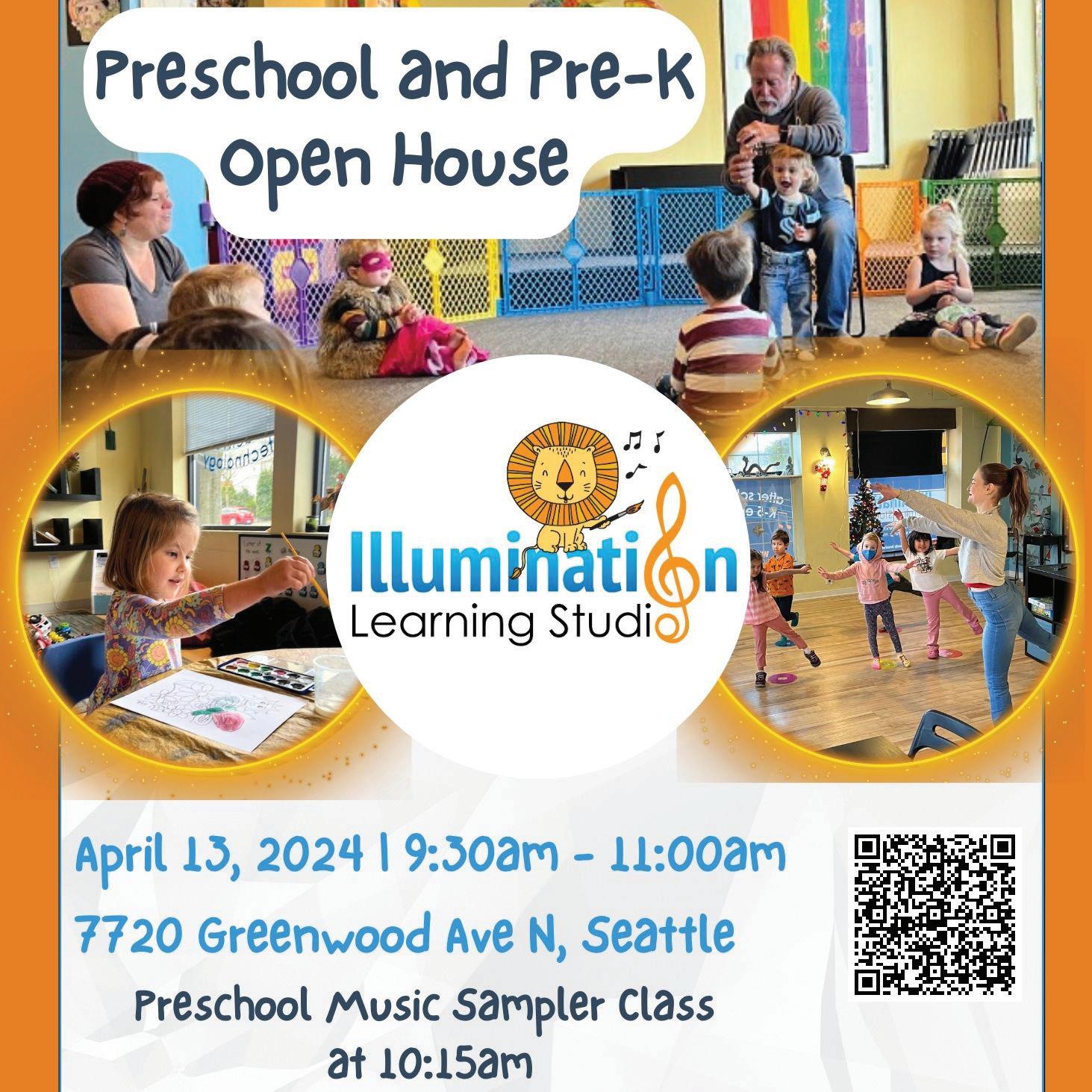
everlovelearning.com
102nd Ave. NE, Bellevue Family-based daycare for children ages 1-3
3321
Child-to-teacher ratio of 3:1
5 Minutes from Bellevue Downtown
♥
Nutritious meals & snacks Your li le one is in hands!caring Now Enrolling Inscripciones Abiertas Bilingual,
Bicultural, Bilaterate 9 Toddlers (1-3.5 years)
PreK (3.5-5 years)
grade
Kindergarten - 8th
info@seattleamistadschool.org SEATTLEAMISTADSCHOOL.ORG
Paid Advertising Section March/April 2024 SEATTLE’S CHILD 39




We know how young children learn best.





Primrose School of West Bellevue
Ages 6 weeks-5 years old
1150 114th Ave. SE, Bellevue 98004 425-315-7305
Admin@PrimroseWestBellevue.com
PrimroseWestBellevue.com
Learning is exciting, and your child is built to learn with a natural curiosity that knows no bounds. Through a balance of play and nurturing guidance, Primrose teachers foster that curiosity and help your child feel a sense of pride and accomplishment that lays the foundation for a lifelong love of learning. Offering year-round STEAM-based programs and summer adventure activities.
Seattle Amistad School
Ages 1-5, Grades K-8
1501 10th Ave. E, Seattle 98102 206-325-3172
info@seattleamistadschool.org
seattleamistadschool.org
Seattle Amistad School is an independent two-way (Spanish-English) school serving toddlers, Pre-K, and kindergarten through 8th grade. At Amistad, we radically commit to excellence, joy, justice, and liberation for black, brown, immigrant, and indigenous children and families and American people. For teachers, children and families, Amistad feels like home.









Each Primrose school is a privately owned and operated franchise. Primrose Schools is a registered trademark of Primrose School Franchising SPE, LLC. ©2024 Primrose School Franchising SPE, LLC. All rights reserved. Now Enrolling Primrose School of West Bellevue 425.315.7305 | PrimroseWestBellevue.com We know that children learn best when they are engaged, challenged and enjoying themselves. That’s why Primrose school teachers use a balance of purposeful play and nurturing guidance to make the most of every day.
40 SEATTLE’S CHILD March/April 2024 Paid Advertising Section
»Summer Summer Directory
It’s time to sign up for summer camps and classes! Here are a few to choose from to enrich your child’s summer break with new experiences. Be sure to also check out our Summer Camps and Classes Directory at 3seattleschild.com, loaded with 90+ programs to choose from around Puget Sound — sort by age, location, type of activity, and more.
Bach To Rock
Ages
8451
Suite 120, Redmond 98052 206-880-1215
redmond@bachtorock.com
bachtorock.com/redmond/ music-camps
Bach to Rock music camps give kids the chance to unleash their inner rock star — even if they’ve never played an instrument before! We offer weeklong summer music camps for kids and teens - both full-day and half-day options are available. Kids have a blast learning to play hit songs and performing with other campers.
Bellevue Children’s Academy
Grades Pre-K-4
14640 NE 24th St., Bellevue 98007 425-649-0791 Option 2 summer@bcacademy.com bcacademy.com/programs/ summerschool
BCA Summer School offers Pre-K to 4th-grade students an excellent opportunity to reinforce learning and prepare for the upcoming school year. Our program includes a thought-provoking English and math curriculum and exciting activities involving project-based science and social studies units that promote creativity, independent thinking and self-confidence.
Camp Galileo: Innovation, Friendship and Fun
Grades K-8
The Bush School 3400 E. Harrison St., Seattle 98112
Gregory Heights Elementary School, 16201 16th Ave. SW, Burien 98166
1-800-854-3684
info@galileo-camps.com galileo-camps.com
At Camp Galileo, every week is a oneof-a-kind adventure full of engaging

























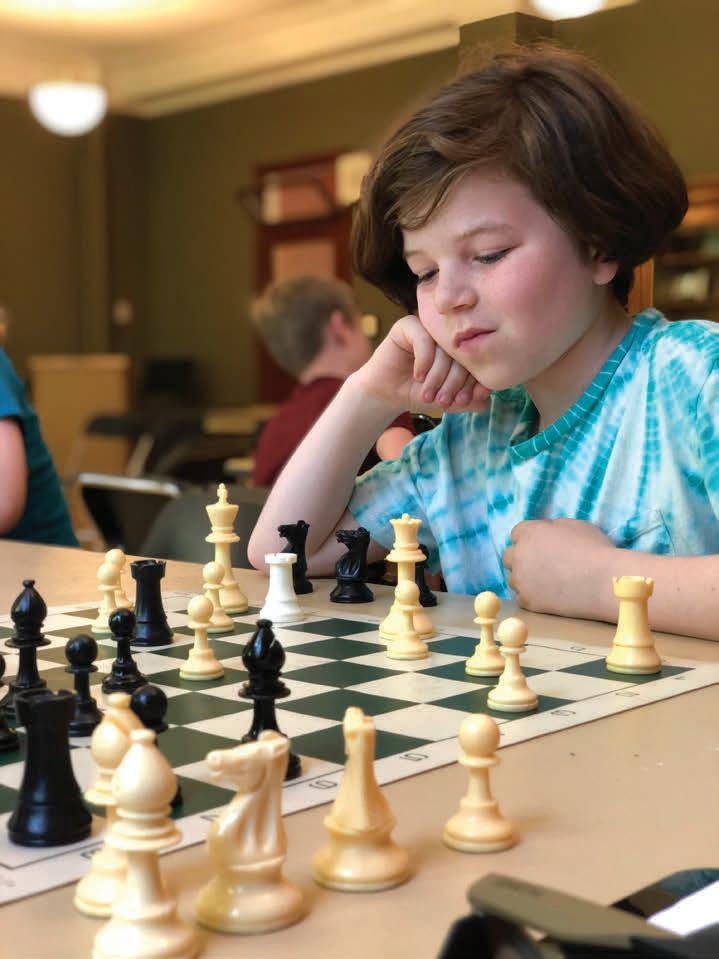

























SUMMER CAMP Register today! www.soundview.org (425) 778-8572 Soundview Summer Camp is guided by certified, professional educators. Soundview: a small, independent school in Lynwood, WA REGISTer Today! C M Y CM MY CY CMY K SeattlesChild_Villa Ventures_1-3-Page_March.pdf 2 2/7/24 3:37 PM
4-17
164th
NE,
Ave.
Paid Advertising Section March/April 2024 SEATTLE’S CHILD 41
Summer Music Camps




























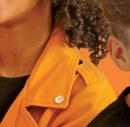













STEAM projects, collaborative design challenges and classic camp fun.


























Grounded in the acclaimed Galileo Innovation Approach, our hands-on activities and outdoor games cultivate essential skills—including collaboration, perseverance and creative confidence—that last long after summer ends. Financial aid available through our Innovation for All program. Extended care 8 a.m.–6 p.m
Camp Gallagher
Grades 6-12
1304 Russell Rd. SW, Lakebay 98349 1-888-658-2230 info@campgallagher.org campgallagher.org



Situated on the sunny shores of Case Inlet in south Puget Sound, Camp Gallagher is one of the most beautiful summer camps in the world. It’s a place where middle and high schoolers can embrace nature, friendship, adventure and stewardship in a truly spectacular setting. The Gallagher community is intentionally diverse. Campers of all genders, races, abilities and sexual orientations are celebrated here. Love Summer. Love Gallagher.

Debate Camp
Grades 5-10
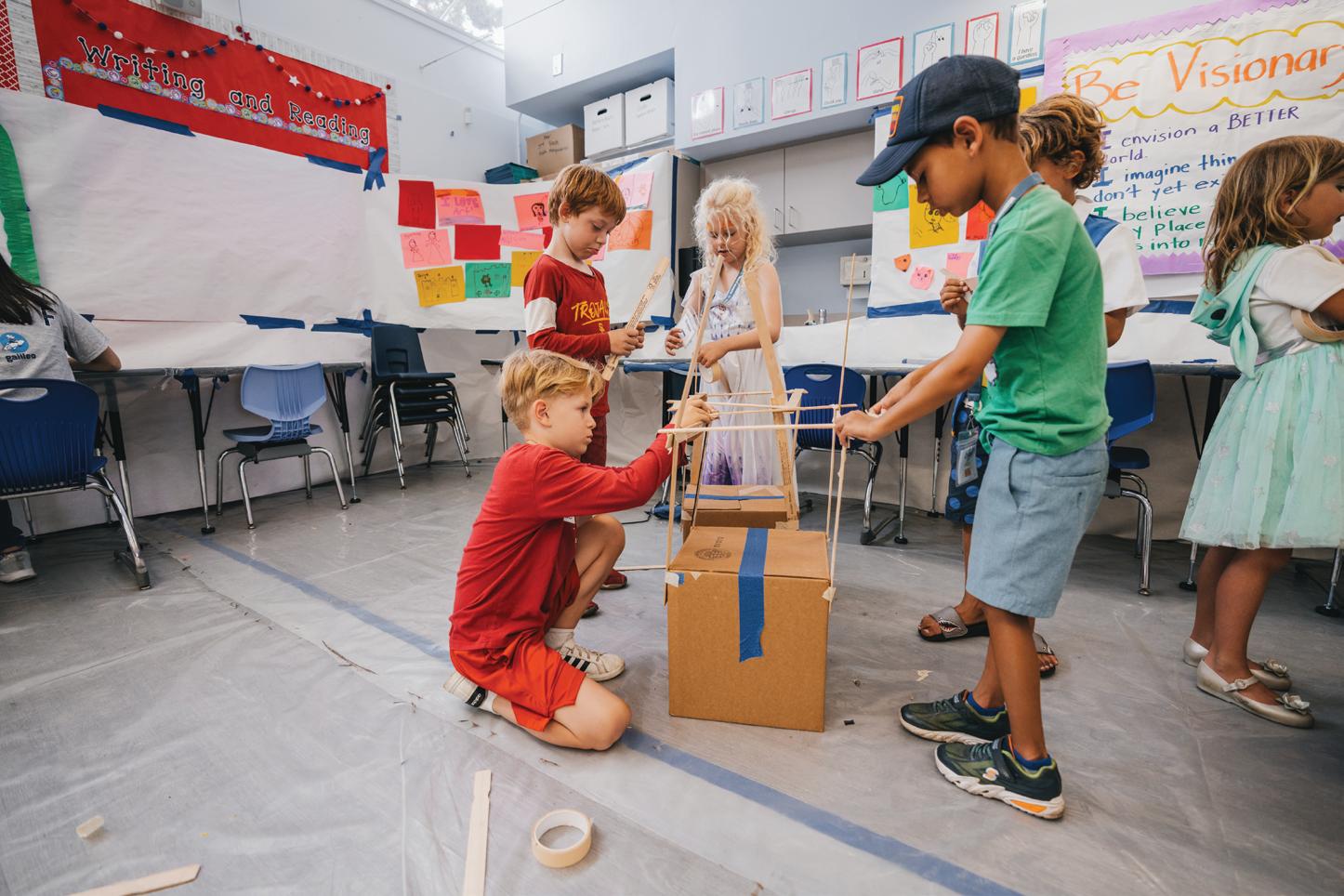

3400 E. Harrison St., Seattle 98112 888-512-8154 debatecamp.com/seattle
Debate Camp specializes in public speaking, parliamentary debate, and Model United Nations. We provide a fun and inspiring space for youth to develop important skills, hear opposing views, and confidently articulate their ideas well in the company of others. 2024 day camp options for Seattle families include two 1-week day camps at The Bush School location and a well-loved overnight camp at Brentwood College on Vancouver Island.
Girls Rock Math
Grades 1-8
Locations in Bellevue, Seattle and Shoreline 206-408-8078
girlsrockmath.org
Girls Rock Math is an empowering, arts-based math camp. Our camps offer engaging themes that capture a girl’s interest and imagination, and we use that as a catalyst for math growth through real-life, hands-on math projects. Creative and fun experiences with math help develop confidence, excitement, and joy around learning.
Where K-8th kids become innovators Unforgettable summer fun beginning June 24 Returning to Seattle Madison Valley and introducing Burien! Sessions filling quickly! Secure your spot: enrollcampgalileo.com/seattle SIG N U P F O R O U R R E GI ST E R O NLINE ! For Ages 4+ Full and Half Da a bachtorock.com/redmond 206-880-1215
www.swim.guru 206-200-9449 | Seattle • Lynnwood • Bellevue
ILLUSTRATION COURTESY OF KATE ENDLE 42 SEATTLE’S CHILD March/April 2024 Paid Advertising Section



































AWARD-WINNING, OUTDOOR CHILDREN’S ART CLASSES & CAMPS! 206-632-2530 • NeoArtSchool@gmail.com FULL WEEK CAMPS 8 AM - 6 PM Plus extended care and half days available! Download the Summer 2024 Packet from our website! Creative and nurturing art classes for children since 1982 Find more information at NeoArtSchool.com Summer Program Begins June 17th Celebrating over 40 years! Paid Advertising Section March/April 2024 SEATTLE’S CHILD 43


MEET THE Camp
Meet the



BCA® SUMMER SCHOOL
Grades Pre-K-4
14640 NE 24th St., Bellevue 98007
425-649-0791, Option 2
summer@bcacademy.com
bcacademy.com/programs/summerschool
Summer School at Bellevue Children’s Academy®, welcoming BCA and non-BCA students, is a great way to reinforce learning and prepare for the new school year. Our program includes three theme-based sessions, each with thought-provoking English and math curriculum, and exciting activities of projectbased science, and social studies units that promote creativity, independent thinking, and self-confidence. A warm and nurturing environment of small classes, BCA Summer School provides fun and learning facilitated by dedicated BCA staff and teachers. Sessions are offered in English and Japanese.
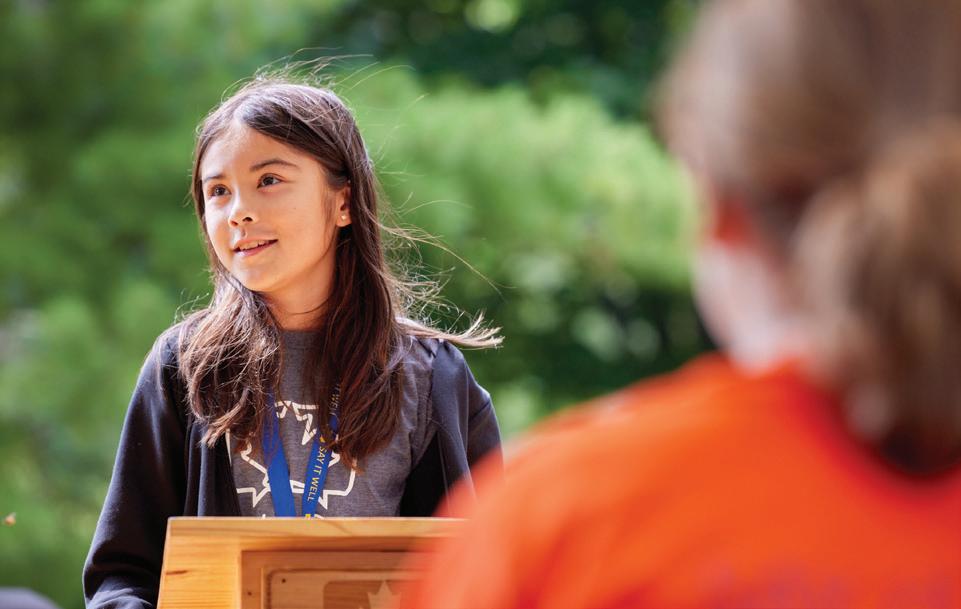
DEBATE CAMP
Ages 10-16
Day Camp The Bush School, 3400 East Harrison St., Seattle Overnight Camp Mill Bay, BC
1-888-512-8154
debatecamp.com/seattle


At Debate Camp, we provide a fun and inspiring space for youth to develop some timelessly important skills; to hear opposing views and confidently articulate their ideas well in the company of others. Debate Camp specializes in parliamentary debate, impromptu and prepared public speaking. We ensure that all program areas are highly interactive and suited to a variety of age groups (grades 5 to 10). All camp locations have multi-level instruction designed for all ability levels; novice to competitive. Enrichment in a fun and traditional camp program. Day and Overnight Camp options now available for Seattle campers. Join us!
Take a closer l k at these camps!

CAMP GALLAGHER
Grades 6-12
1304 Russell Rd. SW, Lakebay, WA 9834 888-658-2230
info@campgallagher.org campgallagher.org
Situated on the sunny shores of Case Inlet in the south Puget Sound, Camp Gallagher is one of the most beautiful summer camps in the world. It’s a place where middle schoolers and high schoolers can embrace nature, friendship, adventure and stewardship in a truly spectacular setting. The Gallagher community is intentionally diverse. Campers of all genders, races, abilities and sexual orientations are celebrated here.
Love Summer. Love Gallagher.

GIRLS ROCK MATH
Grades 1-6
3201 E. Republican St., Seattle 98112 206-408-8078
camp@girlsrockmath.org
GirlsRockMath.org
Girls Rock Math is an arts-based math camp focused on empowering girls in STEAM subjects. Our hands-on themes capture the imagination, ignite deeper mathematical thinking, and help campers feel confident in their abilities. As part of a community where “Girl Power” rules, our campers develop leadership skills, make friends, take on challenges, and learn together in a meaningful way. With so many curricular themes to choose among, there is truly something for everyone.
44 SEATTLE’S CHILD March/April 2024 Paid Advertising
44 SEATTLE’S CHILD March/April 2024 Paid Advertising Section


THE NORTHWEST SCHOOL SUMMER CAMP
Ages 10-16
1415 Summit Ave., Seattle 98122 206-816-6070
nwssummer@northwestschool.org northwestschool.org/summer
Life is a grand adventure with endless possibilities. You never know where it may take you. So stretch and explore this summer. Dance, make music, act onstage and bring an artistic vision to life. Dive into Marine Biology, design a robot or build an architectural model. It’s all possible this summer. You’ll also appreciate our outstanding arts and sports facilities, including an indoor gym, rooftop field, dance studio, black-box theatre, ceramics studio, photography darkroom and science labs. Full-day and half-day options available.
SummerDirectory
IslandWood
Grades 1-6
Brightwater Education Center, Woodinville 22505 State Route 9 S.E., Woodinville 98072 206-855-4300, campregistrar@islandwood.org islandwood.org/outdoorsummer-day-camps
Kids can learn to build like a beaver this summer, travel on a forest safari, and meet animal superheroes at the Brightwater Education Center in Woodinville. Nestled amidst wondrous forests, sparkling streams, and playful trails, the campus features 72 acres of discovery and endless possibilities.
Neo Art School
Summer Art Camp
Ages 6-12
Good Shepherd Center
4649 Sunnyside Ave. N, #121, Seattle 98103 206-632-2530, neoartschool@gmail.com neoartschool.com
Founded in 1982, family owned and operated for two generations, Neo Art School offers the highest quality fine arts and pottery classes for children (and adults) in the Northwest. Summer Camp 2024 and all other School Break Camp enrollment are now open. Offering day camp during the school year and week-long camps during the summer, full-day, and half-day options are available with extended care.


PRIMROSE SCHOOL OF WEST BELLEVUE SUMMER ADVENTURE PROGRAM
Ages 6 weeks-5 years 1150 114th Ave. SE, Bellevue 98004 425-315-7305
admin@primrosewestbellevue.com primrosewestbellevue.com
Learning is exciting, and your child is built to learn with a natural curiosity that knows no bounds. Through a balance of play and nurturing guidance, Primrose School of West Bellevue teachers foster that curiosity and help your child feel a sense of pride and accomplishment that lays the foundation for a lifelong love of learning. Offering year-round STEAM-based programs with summer adventure activities and freshly made healthy meals. Enrolling Infants-PreK. Join us for an upcoming open house or private tour.
Camps start June 17.
Northwest School Summer Camp
Ages 10-16
1415 Summit Ave., Seattle 98122 206-816-6070
northwestschool.org/summer
Explore, learn and make friends—locally and globally! Are you ready for a summer camp that’s fun and engaging and offers a variety of classes? You can dance, make music, act onstage and bring an artistic vision to life, dive into marine biology, design a robot or build an architectural model. It is all possible this summer.
Pacific Science Center Camps for Curious Minds
Grades Pre-K-8
200 2nd Ave. N, Seattle 98109 206-443-2001, camps@pacsci.org pacsci.org/camps
Find PacSci’s Camps for Curious Minds at six locations across Puget Sound this summer: PacSci campus, Explorer West Middle School, Mercer Slough Environmental Education Center, St. Thomas School, Salish Sea Elementary and Eastside Preparatory School. PacSci offers sensory-friendly camps and camps designed for a range of mobility needs. Scholarships available.
Primrose School of West Bellevue Summer Adventure Program
Ages 6 weeks-5 years old 1150 114th Ave. SE, Bellevue 98004 425-315-7305 admin@PrimroseWestBellevue.com PrimroseWestBellevue.com
Learning is exciting, and your child is built to learn with a natural curiosity that knows no bounds. Through a balance of play and nurturing guidance, Primrose teachers foster that curiosity and help your child feel pride and accomplishment that lays the foundation for a lifelong love of learning. Offering year-round STEAM-based programs with summer adventure activities and freshly made healthy meals.
RSM
Grades K-12
Locations in Bellevue, Factoria and Redmond bellevue@mathschool.com factoria@mathschool.com redmond@mathschool.com mathschool.com
The Russian School of Mathematics is an award-winning, after-school math program for K-12 students. Recently named “among the top schools in the world” by the Johns Hopkins CTY, we help children of all levels excel in mathematics. At RSM, we believe all children can develop a solid foundation in math if taught correctly.
MEET THE Camp
Paid Advertising Section March/April 2024 SEATTLE’S CHILD 45
IslandWood Summer Day Camps at Brightwater
Full-day camps for kids entering 1st through 6th grades
WHERE NATURE CLASSROOMS COME ALIVE!

July 1 - August 9
Brightwater Education Center

22505 State Route 9 S.E. Woodinville, 98072
islandwood.org/bwcamps

Seattle Shakespeare Company
Camp Bill Summer Camp
Grades 6-12
Locations: Center Theatre at Seattle Center and Luther Burbank Park, Mercer Island 206-733-8228
education@seattle shakespeare.org
seattleshakespeare.org/ camp-bill/

Students will be cast in an indoor production of As You Like It or an outdoor Julius Caesar. Spend three weeks rehearsing, playing games, working on text, and delving into all aspects of the theatrical storytelling from text to costumes to sets to performance. These all-inclusive production intensives culminate in two performances over the weekend after camp wraps up.
Soundview School
Ages 3-13
6515 196th St. SW, Lynnwood 98036 425-778-8572
ctaylor@soundview.org
soundview.org/auxiliary-programs
Soundview is thrilled to announce the opening of registrations for its exciting summer programs. Our diverse range of classes ensures a vibrant and enriching experience for everyone. With guidance from our certified professional educators, participants explore tailored activities, fostering a hands-on and engaging educational environment. Register now for an unforgettable educational journey filled with exploration, creativity, and leadership development.
Starfire
Starfire Aviation & Space
STEAM Camp
Ages 6-11
14800 Starfire Way, Tukwila 98188 206-431-3232 academy@starfiresports.com starfiresports.com/youth/starfireacademy/stem-summer-camp
In partnership with the Federal Aviation Association and the Museum of Flight, Starfire is excited to inspire and empower campers to reach new heights through aviation and space exploration! Campers will have a stellar time learning to code and fly drones, experiencing flight through the Museum of Flight’s Flight Simulator, and working together to solve out-of-this-world problems.
SwimGuru
Ages 6 months-adult
Seattle, Lynnwood and Bellevue 206-200-9449, support@swim.guru swim.guru
SwimGuru is a drowning prevention program. The focus for every client is to develop a functional swim-floatswim and be able to independently problem-solve in any depth of water. SwimGuru is a start-to-finish program that gives clients life-saving
SIGN UP NOW!
ILLUSTRATION COURTESY OF KATE ENDLE
ILLUSTRATION COURTESY OF KATE ENDLE 46 SEATTLE’S CHILD March/April 2024 Paid Advertising Section
skills in months, not years.
The Music Factory
Ages 8-18
2832 E Arthur Pl., Seattle 98112 206-420-3896
info@musicfactorynw.com
musicfactorynw.com
Are you ready to rock? The Music Factory teaches guitar, piano, ukulele, singing, and more. We teach all ages and will work with you at any skill level. Jam out in a Cover Band, sing along to popular tunes on Ukulele & Songs (for ages 5-18), write a rock opera in Songwriting, or create beats and drop tracks in Music Production!
Villa Ventures: The Ultimate Summer Adventure
Ages 4-17
5001 NE 50th St., Seattle 98105 206-524-8885
enrollment@thevilla.org
thevilla.org/summer
Villa Ventures provides the largest, most robust summer camp experience in Seattle. Located on Villa Academy’s campus, Villa Ventures Summer Camps feature high-quality, engaging outdoor and indoor experiences designed for curious and creative minds ages 4 to 17. There are activities for everyone—carpentry, coding, forest games, and more.

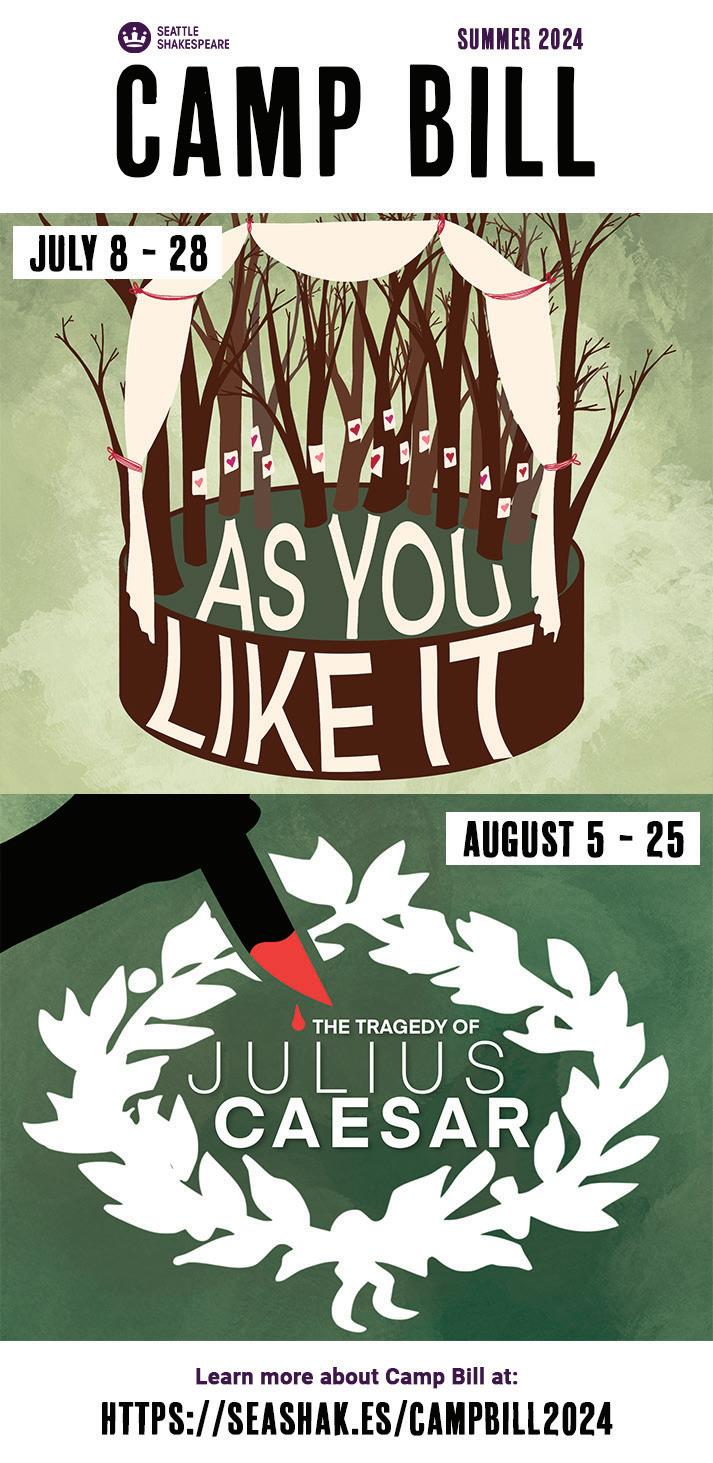


this Summer
RSM is an award-winning after-school math enrichment program. Students can choose from a variety of K-12 courses that will be taught during our 6-week summer session.
RSM is “among the top 10 schools in the world.” – Johns Hopkins Center for Talented Youth
Schedule a FREE Math Evaluation! Math Classes Now Enrolling! Redmond (425) 616-3511 Factoria (425) 230-6452 Bellevue (425) 518-6114 3 Locations in WA MathSchool.com
ADVANCE IN MATH
LEARN MORE
Paid Advertising Section March/April 2024 SEATTLE’S CHILD 47

A Very Sunriver Spring



Sunriver Resort is the Pacific Northwest’s all-season outpost for adventure. This spring, let the kids rule! Kids eat and play for free with our Kids Rule lodging offer. Whether it’s cruising the 40 miles of paved bike paths, making a splash at the Cove Aquatic Center, ice skating in the Village, or sharing a meal together at one of our premier dining outlets, Sunriver Resort will provide endless adventure for the whole family. This spring, create cherished memories that will last a lifetime. Kids


Getaway at SunriverResort.com/offers
Eat and Play for Free This Spring! Book Your






































































































































































































































































































































































































